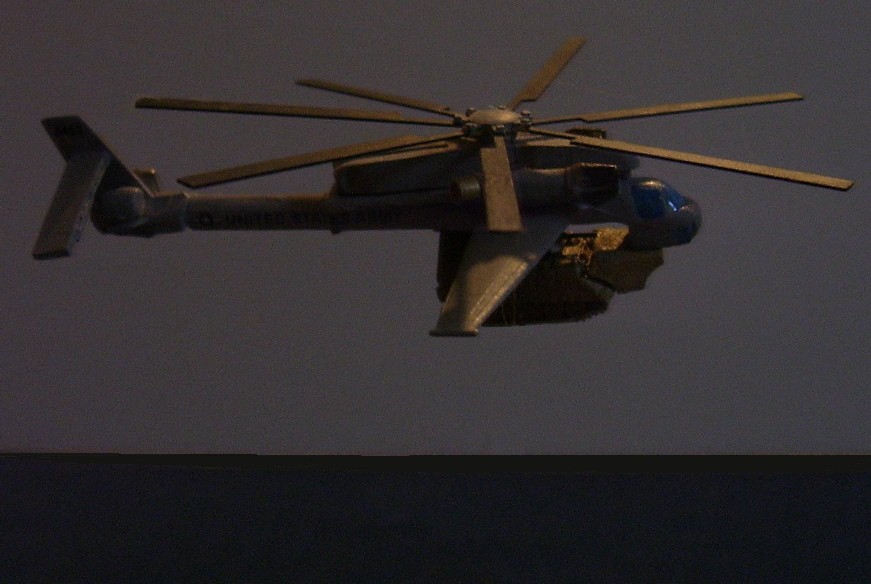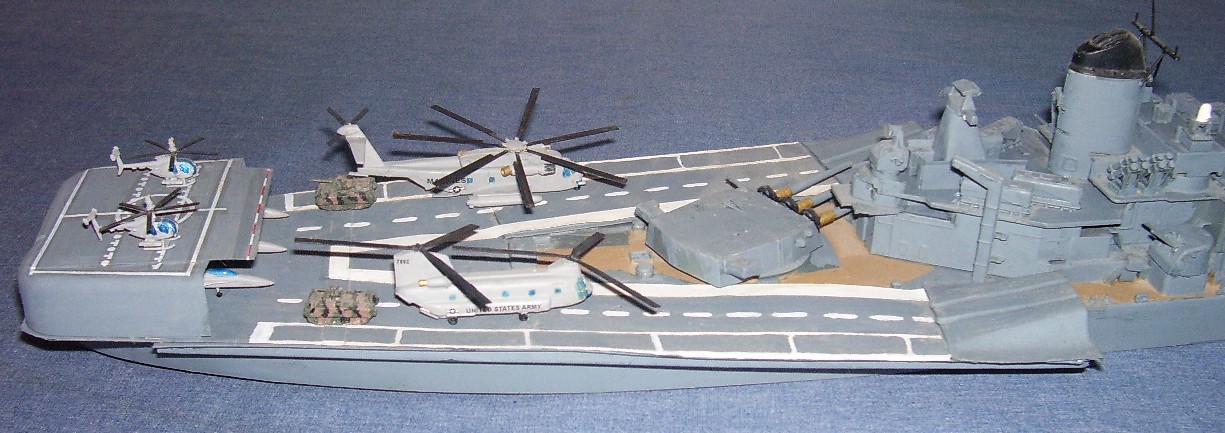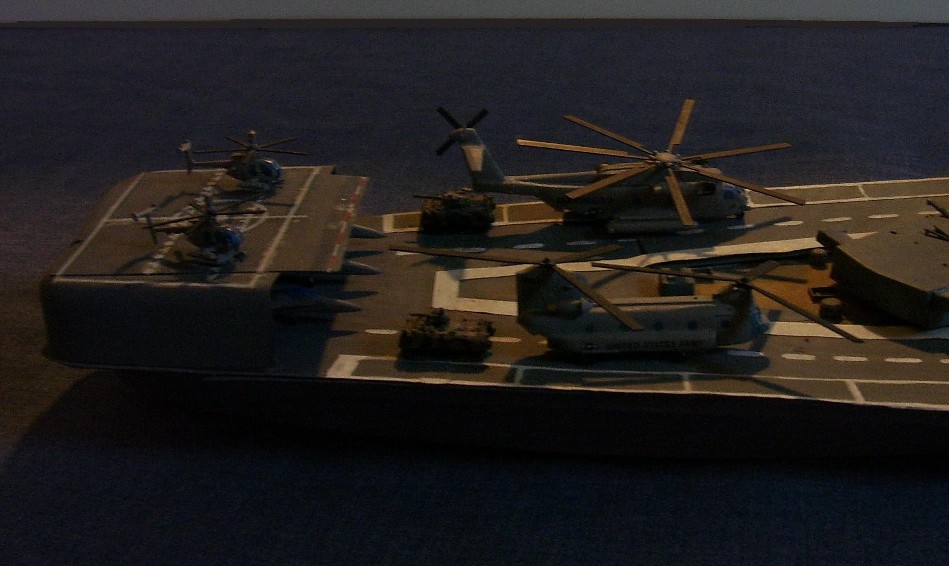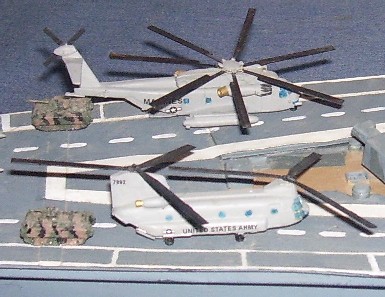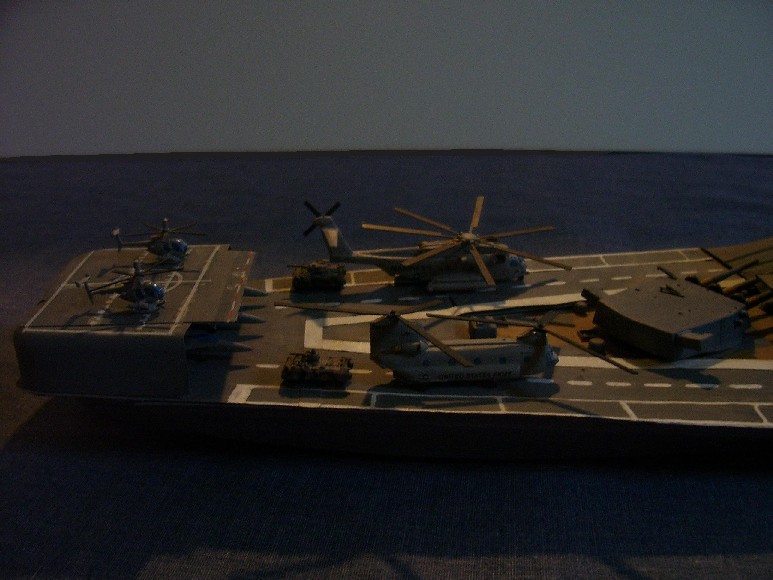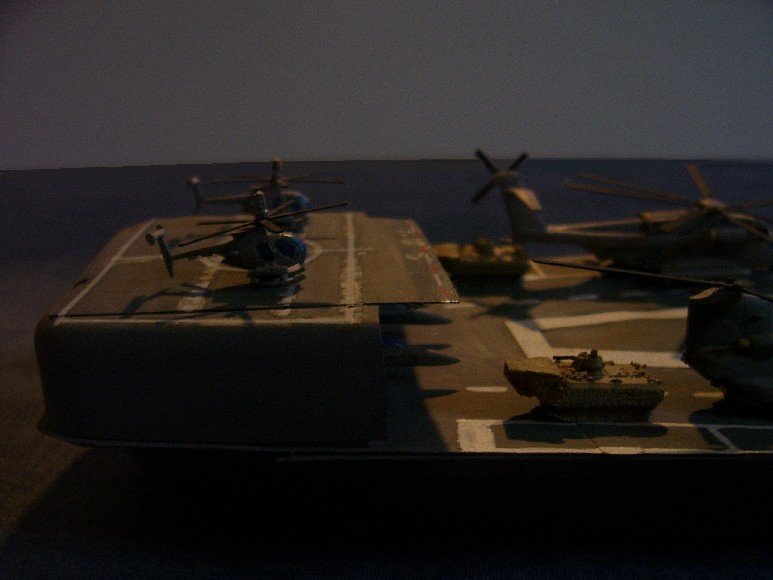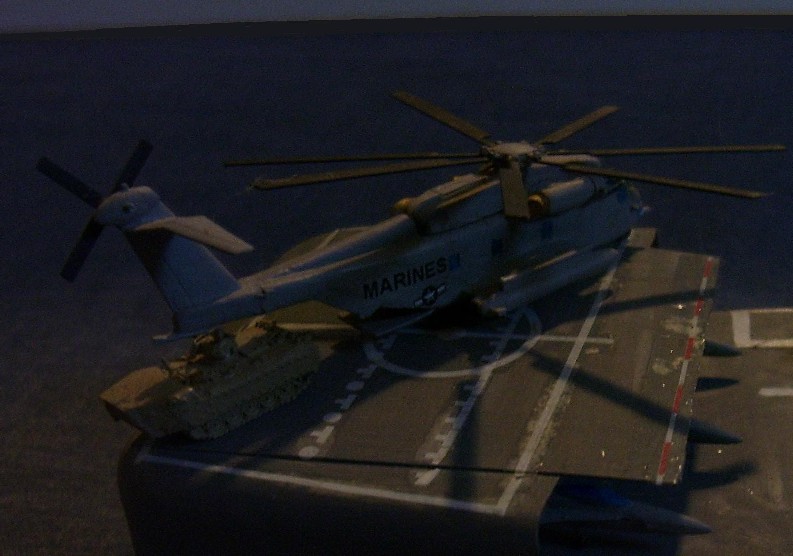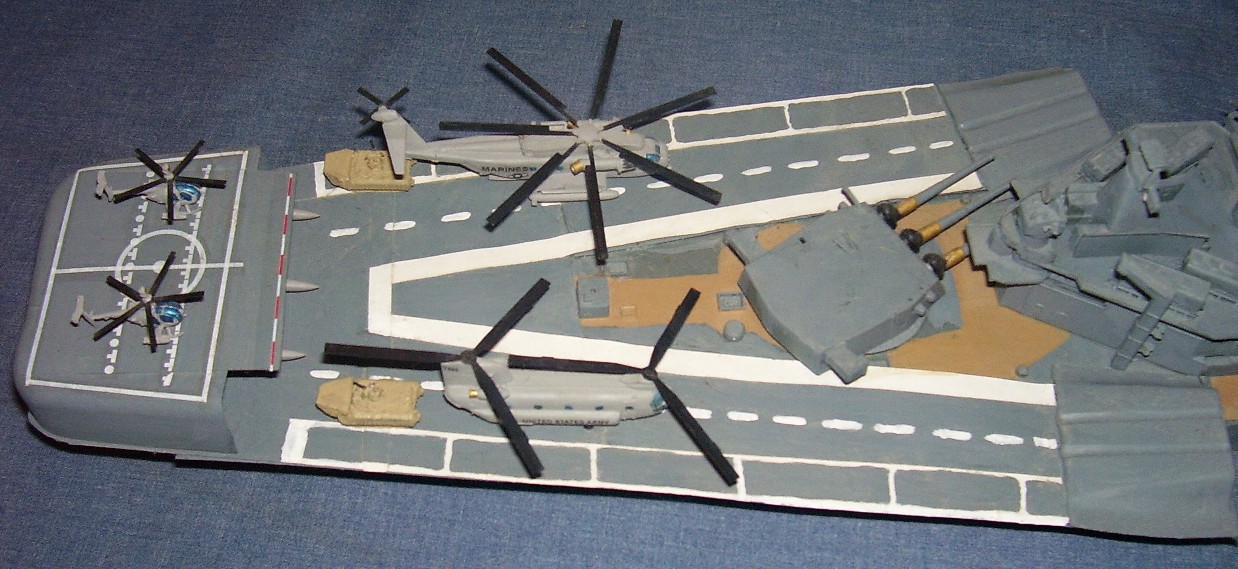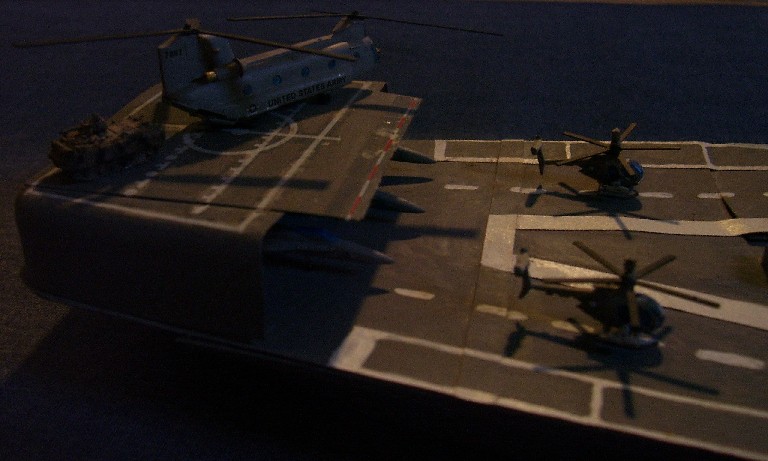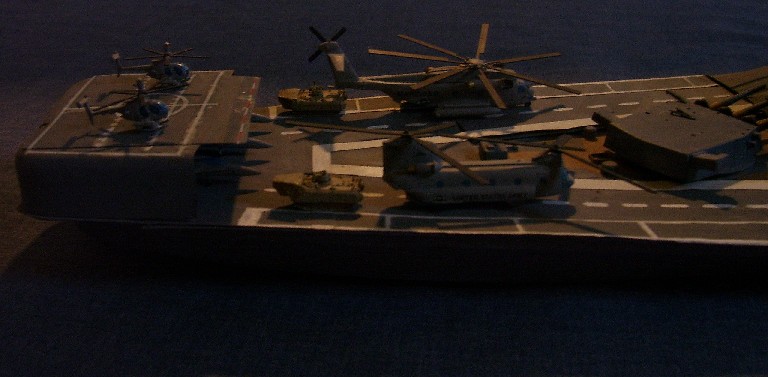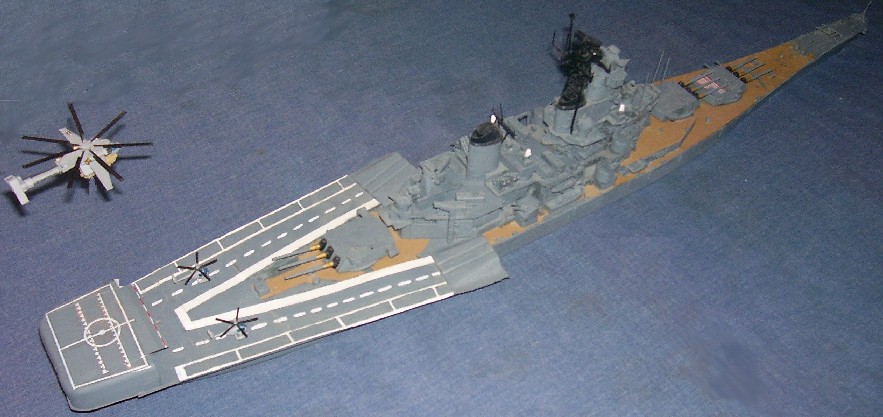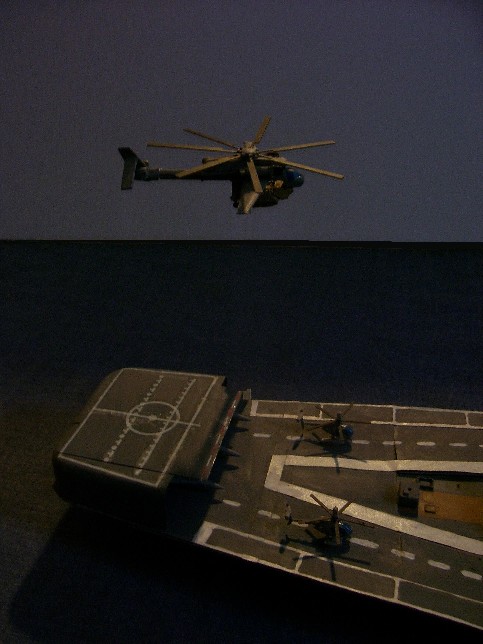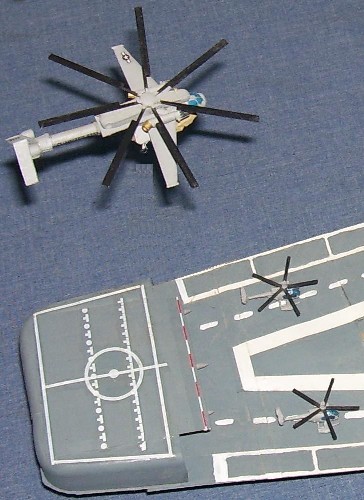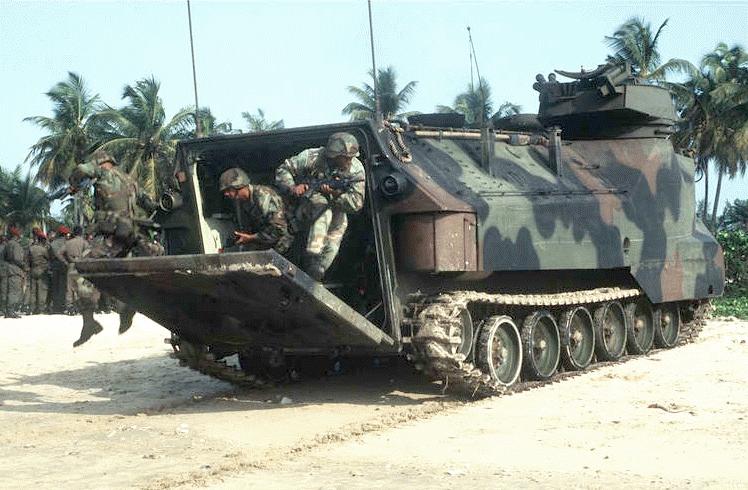
www.combatreform.org/macgregoronUSMCamtracktragedy.wmv
BACKGROUND STORY:
As soon as the tracked tank appeared to overcome the deadlock of narcissist foot infantry in WW1 trenches, inventors like Walter Christie and Donald Roebling soon created amphibious versions. Roebling was the first to create an amphibious tractor (AMTRACK) that was buoyant and propelled itself strongly enough to swim a short distance from ship-to-shore. His early Landing Vehicles Tracked (LVTs) were unarmored and suffered heavy losses in early WW2 amphibious beach assaults. He quickly fixed this by adding enough thin steel to make the follow-on LVT2s, 3s and 4s small caliber bullet-proof but because steel is very heavy, he could not fully enclose the hull, so marines and Army Soldiers died from enemy fire reaching through the open tops. The Germans also fielded armored tracked amphibious tanks in WW2.
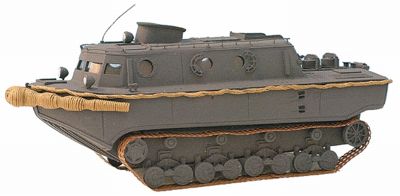
German WW2 amtrack
Amtrack designers not only had the problem of trying to fully enclose the rifle squad with steel which created such U.S. Army monsters as the M75 and M59, they had to have the vehicle float with enough freeboard to survive ocean waves and beach surf conditions. Infantry fire support "male" gun light tanks like the PT76 do not need to carry infantry so they need less volume but this makes it harder for their hulls to displace water and float. The CHICOM improvements to the PT76 with a shoot-on-the-move 105mm main gun are very troubling as they have made the world's most effective light amphibious tank capable of killing heavier inland tanks.
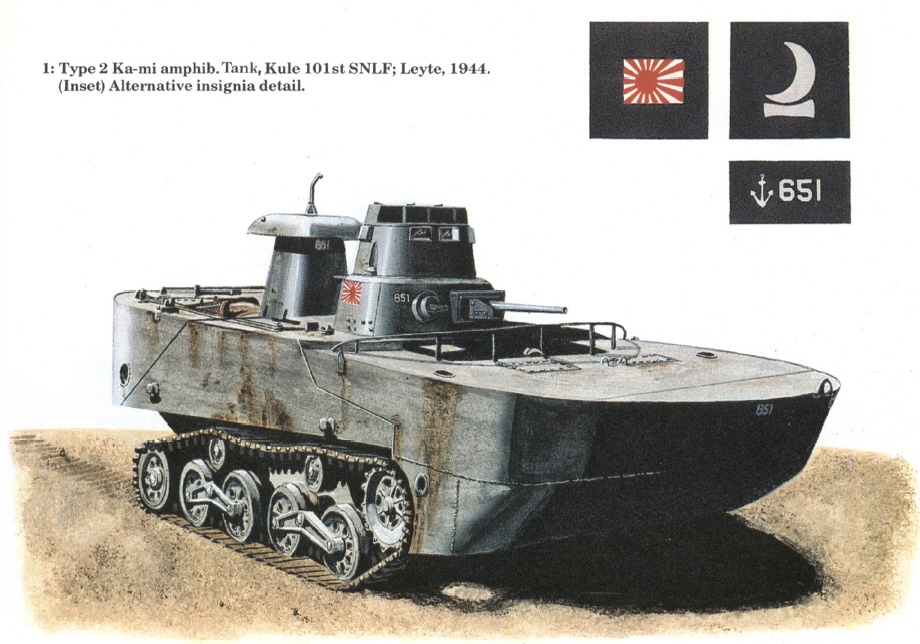
Note the enlarged nose section for swimming on this Japanese amphibious light gun tank for infantry fire spport from WW2, this front hull overhang ruins cross-country mobility over uneven ground
The foot infantry narcissist USMC however, in an absurd choice to make a larger boat hull shape but more based on deep-seated, anti-mechanized prejudice made matters even worse by insisting on using fewer amtracks carrying more than a reasonable rifle squad each with dozens of men--like the M75/M59---in the post-WW2 bloated LVTP5 series that could carry 34 men! Not only on sea, but on land these created huge targets for the enemy to hit and destroy; they also handicapped ground mobility inland so the USMC infantryman ended up walking ahead in WW1 fashion. Consider the 1965 debacle in Vietnam, "Operation Starlite".
The advent of FMC (now UDLP) employing aluminum alloy armor to fully enclose the rifle squad with the M113 Gavin in 1956 and fielded throughout the U.S. Army in 1960 revolutioned land warfare forever. Finally, we had a fully protected APC that could be air transported in C-130 aircraft and float to swim across lakes and rivers. In fact, heavy lift helicopters can lift the Gavin from ship-to-shore. However, the Army was warned all along that the baseline 7.62mm AP bullet protection of the M113 Gavin's hull was ONLY THE STARTING POINT; that add-on armor would be needed to defeat RPGs and other weaponry as time wore on.
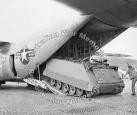
The LVTP7 now called the "AAV7" was born.
During minor conflicts like Grenada, and major linear conflicts like Gulf War 1 (Desert Storm) where AAV7s were hidden amongst better armored and armed tanks losses were avoided. Despite their overly large size, the USMC finally realized that their amtracks needed more armor but could only add it in a few locations without busting the vehicle's suspension and drivetrain. If you start with an overly large armored box you simply cannot add armor all around. To help prevent amtracks from being ambushed, a 20-40mm autocannon turret can sometimes "shoot your way out of trouble".
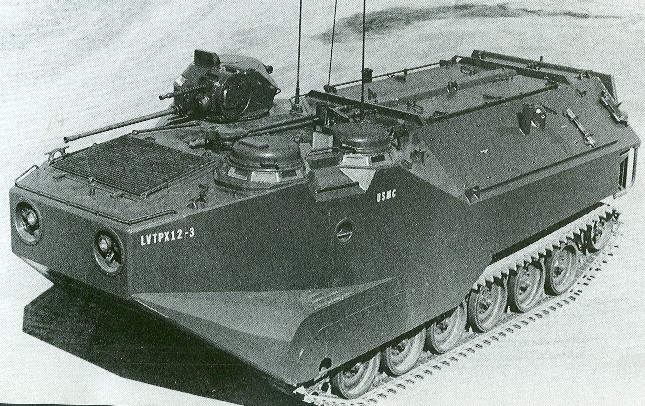
(Photo of LVTP7 prototype with 20mm autocannon/7.62mm medium machine gun turret is from Hunnicutt, "Bradley: a History of American Fighting and Support Vehicles", page 343)
When the USMC bought the LVTP7 it had the combat-proven M39 20mm autocannon in its one-man power-operated turret that could have acted as a "female" tank supplying enemy smothering firepower. However, the cheapskate and foot infantry egomaniac, HQMC rejected the autocannon and placed the impotent and defective M85 .50 caliber heavy machine gun turret on all its amtracks. No large caliber assault gun variants were obtained to act as "male tanks", either. Even the LVTP5 had a 105mm howitzer version (LVTH6) that was helpful in Vietnam. It was if the USMC was stuck in a feel-good reliving of WW2 beach assaults and a pre-WWI time warp of its own choosing if it went inland.
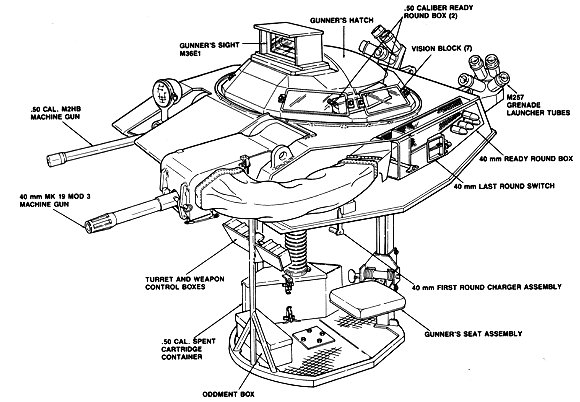
This defective turret was replaced years later with an "up-gunned weapons station" with a M2 MaDeuce .50 caliber HMG that indeed works and a 40mm low-velocity 40mm grenade launcher, but this combination lacks the firepower to punch through buildings as we are seeing now tragically in Iraq. No gunshields were placed in back so troops could stand up and fire their rifles/machine guns to suppress enemy ambusher's RPG aim. The stage was set for a disaster.
Bloated AAV7 Deathtraps for our men in Iraq today
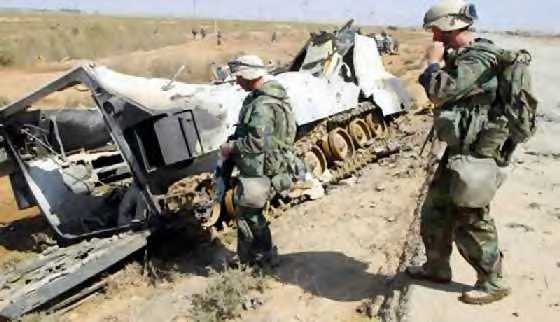
Fast forward to 2003...during Gulf War 2, "Operation Iraqi Freedom" (OIF) AAV7s were unwisely packed full of ammunition and rockets and driven through the city of Nasiriyah when a company of bloated amtracks got stuck in soft mud trying to bypass the town. Without tactical training and FLIR for drivers to use smokescreens, enemy RPG gunners poured rocket after rocket into AAV7s until they penetrated portions of the hull where there was no add-on armor and exploded the ammunition, rockets and fuel inside. We will refrain from revealing where the fuel is in AAV7s, but its location while better than the floor of the LVTP5s is still not wise. Dozens of marines were horribly killed and wounded.
The thing that is immoral is that 2 years later, the USMC is still driving around AAV7s packed full of ammo and men in Iraq with disastrous consequenses.
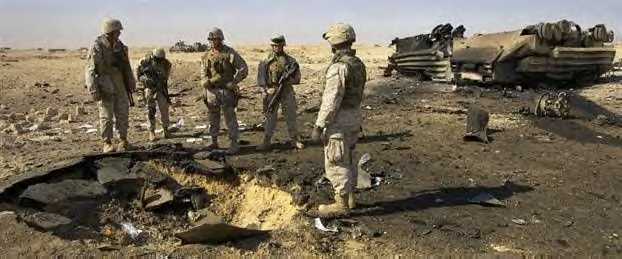
www.yahoo.com/_ylh=X3oDMTExczRtdWkyBF9TAzI3MTYxNDkEdGVzdAN2Mjc1BHRtcGwDdjI3NS1 pZQ--/s/24925214 U.S. marines Are Killed in Iraq
By TINI TRAN, Associated Press Writer
BAGHDAD, Iraq - A marine amphibious assault vehicle on patrol during combat operations near the Syrian border hit a roadside bomb Wednesday, and 14 marines were killed in one of the deadliest single attacks in Iraq against American forces.
A civilian interpreter also was killed in the bombing, which came two days after seven marines died in the same area during combat with insurgents. At least 1,820 members of the U.S. military have died since the Iraq war began in March 2003, according to an Associated Press count.
Also, an American freelance journalist was found dead in the southern Iraqi city of Basra, the U.S. Embassy said. Steven Vincent had been shot multiple times after he and his Iraqi translator were abducted at gunpoint hours earlier, police said.
The marines killed Wednesday were assigned to Regimental Combat Team 2, 2nd marine Division, II marine Expeditionary Force (Forward), the military said. One marine also was wounded in the attack.
The explosion occurred just outside Haditha, which is 140 miles northwest of Baghdad.
The marines were riding in an amphibious assault vehicle, which is designed to carry troops from ship to shore and on land. It has a road speed of about 45 mph and can carry up to 25 marines. It is not as heavily armored as the Bradley fighting vehicles that the army uses.
The names of those killed were not released.
The latest losses come on the heels of the deaths of seven U.S. marines in combat two days ago in the volatile Euphrates Valley of western Iraq, where American forces are trying to seal a major border infiltration route for foreign fighters.
One of the marines died in a suicide car bombing in Hit, 85 miles northwest of Baghdad. The other six were killed Monday in Haditha, 50 miles from Hit, while battling insurgents. They all were attached to the same suburban Cleveland unit.
The American deaths come as the Bush administration is talking about handing more security responsibility to the Iraqis and drawing down forces next year.
At least 39 American service members have been killed in Iraq since July 24 - all but two in combat. In addition, the Iraqi Defense Ministry said that since the beginning of April, more than 2,700 Iraqis - about half of them civilians - had been killed in insurgency-related incidents.
The extremist Ansar al-Sunnah Army claimed responsibility for killing the six marines on Monday.
Masked gunmen showed up in the Haditha public market Monday afternoon displaying helmets, flak jackets and other equipment they said were taken from the bodies of the dead marines.
Fighting has intensified in recent weeks in Haditha, Hit and other dusty towns along the Euphrates River as American forces step up efforts to seal off the approaches to the Syrian border.
The marines launched a series of operations in the region in May and June in hopes of pacifying the area so Iraqi military and civilian forces could assume effective control. But the insurgents have proven resilient.
Iraqi police said Vincent, a writer who had been living in New York, had been staying in Basra for several months working on a book about the city's history.
Vincent and was abducted along with his female translator at gunpoint Tuesday evening, police said. His translator, Nour Weidi, was seriously wounded.
They were seized by five gunmen in a police car as they left a currency exchange shop, police Lt. Col. Karim al-Zaidi said.
In an opinion column published July 31 in The New York Times, Vincent wrote that Basra's police force had been heavily infiltrated by members of Shiite political groups, including those loyal to radical cleric Muqtada al-Sadr.
Vincent quoted an unidentified Iraqi police lieutenant as saying that some police were behind many of the assassinations of former Baath Party members that have taken place in Basra.
Vincent's body was discovered on the side of the highway south of Basra later. He had been shot in the head and multiple times in the body, al-Zaidi said.
According to the New York-based Committee to Protect Journalists, at least 46 journalists and 20 media support workers have been killed while covering the war in Iraq since March 2003. Insurgent actions are responsible for the bulk of deaths.
The Vienna, Austria-based media watchdog International Press Institute condemned Vincent's killing and urged Iraqi authorities to conduct a speedy and thorough investigation.
The death underscored how "Iraq continues to be the most dangerous country in the world in which to work as a journalist," the group said.
Washington Post
May 12, 2005
Pg. 1Demise Of A Hard-Fighting Squad Marines Who Survived Ambush Are Killed, Wounded in Blast
By Ellen Knickmeyer, Washington Post Foreign Service
HABAN, Iraq, May 11 -- The explosion enveloped the armored vehicle in flames, sending orange balls of fire bubbling above the trees along the Euphrates River near the Syrian border. Marines in surrounding vehicles threw open their hatches and took off running across the plowed fields, toward the already blackening metal of the destroyed vehicle. Shouting, they pulled to safety those they could, as the flames ignited the bullets, mortar rounds, flares and grenades inside, rocketing them into the sky and across pastures. Gunnery Sgt. Chuck Hurley emerged from the smoke and turmoil around the vehicle, circling toward the spot where helicopters would later land to pick up casualties. As he passed one group of Marines, he uttered one sentence: "That was the same squad."
Among the four marines killed and 10 wounded when an explosive device erupted under their Amtrac on Wednesday were the last battle-ready members of a squad that four days earlier had battled foreign fighters holed up in a house in the town of Ubaydi. In that fight, two squad members were killed and five were wounded. In 96 hours of fighting and ambushes in far western Iraq, the squad had ceased to be.
Every member of the squad -- one of three that make up the 1st Platoon of Lima Company, 3rd Battalion, 25th Regiment -- had been killed or wounded, marines here said. All told, the 1st Platoon -- which Hurley commands -- had sustained 60 percent casualties, demolishing it as a fighting force.
"They used to call it Lucky Lima," said Maj. Steve Lawson, commander of the company. "That turned around and bit us."
Wednesday was the fourth day of fighting in far western Iraq, as the U.S. military continued an assault that has sent more than 1,000 marines down the ungoverned north bank of the Euphrates River in search of foreign fighters crossing the border from Syria. Of seven marines killed so far in the operation, six came come from Lima Company's 1st Platoon.
Lima Company drew marine reservists from across Ohio into the conflict in Iraq. Some were still too young to be bothered much by shaving, or even stubble. They rode to war on a marine Amtrac, an armored vehicle that travels on tank-like treads. Marines in Iraq typically crowd thigh to thigh in the Amtrac, with one or two men perched on cardboard boxes of rations. Only the gunners manning the top hatches of Amtracs have any view of the passing scenery. Those inside find out what their field of combat is when the rear ramp comes down and they run out with weapons ready. Marines typically pass travel time in the Amtrac by extracting favorite bits from ration packets, mercilessly ribbing a usual victim for eating or sleeping too much, or sleeping themselves.
On Monday, when the marine assault on foreign fighters formally began, the young marines of the squad from the 1st Platoon were already exhausted. Their encounter at the house in Ubaydi that morning and the previous night had been the unintended first clash of the operation, pitting them against insurgents who fired armor-piercing bullets up through the floor. It took 12 hours and five assaults by the squad -- plus grenades, bombing by an F/A-18 attack plane, tank rounds and rockets at 20 yards -- to kill the insurgents and permit recovery of the dead marines' bodies.
Afterward, they slept in the moving Amtrac, heads back and mouths agape. One stood up to stretch his legs. He fell asleep again standing up, leaning against the metal walls.
Squad members spoke only to compare what they knew about the condition of their wounded. Getting the latest news, they fell silent again. After one such half-hour of silence, a marine offered a terse commendation for one of the squad members shot at Ubaydi: "Bunker's a good man." With the operation underway, marine commanders kept the 1st Platoon largely to the back, letting its men rest. Commanders had hoped the operation would swiftly capture or kill large numbers of foreign fighters. But the foreigners, and everyone else here, had plenty of warning that the marines were coming -- including those ready to fight at Ubaydi.
By the time the squad from Lima Company crossed north of the Euphrates, whole villages consisted of little more than abandoned houses with fresh tire tracks leading into pastures or homes occupied only by prepubescent boys or old men. Men of fighting age had made themselves scarce. The AK-47 assault rifles ubiquitous in Iraqi households had disappeared. Many marines complained bitterly that commanders had pulled them out of the fight at Ubaydi while the insurgents were still battling, to start the planned offensive. "They take us from killing the people they want us to kill and bring us to these ghost villages," one complained Wednesday on the porch of a house commandeered as a temporary base.
Uneventful house searches stretched into late afternoon, the tedium broken only by small-arms fire and mortar rounds lobbed by insurgents hiding on the far side of the river. This correspondent had just gotten off the Amtrac and the reconstructed squad from 1st Platoon was rolling toward the Euphrates in a row of armored vehicles, headed for more house searches, when the vehicle rolled over the explosive.
Marines initially said they believed the blast was caused by two mines stacked on top of each other. But reports from marines that they had seen an artillery round and two hand-held radios near the blast site raised suspicions that the explosion was caused by a bomb that had been activated remotely, Lawson said. Hurley and others pulled their comrades out of the Amtrac as flames detonated-- or "cooked off," in military jargon -- its ammunition. As marines carrying stretchers ran to the Amtrac, bullets snapped out of the burning hulk and traveled hundreds of feet. The marines ran back through the fusillade, carrying out the wounded. "C'mon, c'mon, c'mon," some shouted, desperate to get the wounded out.
The four dead were trapped inside the vehicle, Lawson said.
"We passed right over it. We passed right over it," one of many marines in the convoy ahead of the burning Amtrac said of the explosive, puzzling over why he was still alive.
"That's the last of the squad," said another, Cpl. Craig Miller, whose reassignment last month had taken him out of the unit. "Three weeks ago, that would have been me."
Late Wednesday, helicopters flew out Hurley and the remaining members of 1st Platoon for time off. They are to return after the platoon is remade, marines said.
Another Lima Company platoon commander ordered his men to bed early, in preparation for the next day's operations. Mourning could wait. "We don't have time," the commander said.
Los Angeles Times
May 12, 2005
Pg. 1An Unseen Enemy marines find themselves vulnerable as they search for insurgents in desert villages of remote western Iraq.
By Solomon Moore, Times Staff Writer
The marines of Kilo Company were on the fourth day of an offensive against insurgents in western Iraq, but they had seen little action Wednesday until a loud boom rocked this Euphrates River village, followed by the frantic screams of young troops. They stopped their convoy and looked back to see an amphibious vehicle engulfed in flames. They knew that about 18 marines from Lima Company of the 3rd Battalion, 25th Regiment, were in the vehicle, which had apparently struck a roadside bomb.
Within minutes, the vehicle's gas tanks exploded, setting off mortar shells, grenades, bars of C-4 plastic explosives and thousands of machine-gun rounds inside. Rockets randomly shot out of the vehicle. The explosives would crackle and thunder for the next hour.
Marines from Kilo, traveling 500 yards ahead of Lima, rushed to rescue their comrades trapped inside the burning wreck. A Times reporter traveling with Kilo Company followed them.
Some troops ran through thick, black smoke and pulled out wounded men, lining up some of them within feet of the fire. Some of the wounded suffered third-degree burns. Seared flesh hung from their bodies. Most of the wounded had severe burns on their arms and faces. Others had shrapnel wounds. A 3-inch shard of metal protruded from one marine's abdomen.
Marines who survived the blast said they believed that four troops died in the vehicle. Officials on the scene and in Baghdad declined to confirm the casualty toll. [EDITOR: later it was confirmed 6 marines were incinerated inside the amtrack]
Lt. Sam McAmis, who commanded a marine platoon in the operation, recounted trying to pull a wounded sergeant from the fire, but the man's ammunition pouch was stuck in the vehicle's hatch. McAmis said he yanked him out. "When he came out, my hand was inside his leg, inside his muscle," he said. Another wounded man inside was not as lucky.
"One of my lance corporals went in to try to get some more people, but there was too much fire," McAmis said. "One marine had burns over his face. The last thing he did was reach his hand out and an explosion went off" killing him. Sgt. Dennis Wollard of Biloxi, Miss., who survived the explosion, sat glassy-eyed and bare-chested against a building on the edge of the field. He lamented that he couldn't save all the men inside.
"I was at the back door," Wollard said. "I couldn't get 'em all. There had to be six still in there. I don't know how they could've gotten out." Another marine, speaking with a senior officer, held back tears. "I couldn't get to them all, sir. It was just too hot," he said, shaking his head. As the marines treated their wounded comrades, retired marine Lt. Col. Oliver North, the Iran-Contra scandal figure, filmed the operation with a digital video recorder issued by his employer, Fox News. North, who was dressed in marine camouflage, is traveling with Kilo Company.
About half an hour after the explosion, two Blackhawk helicopters swooped down to take the wounded to the base at Al Qaim near the Syrian border. The marines in Abu Hardan stood near the blast scene. Some appeared stunned. Others were angry.
"It was my fault, it was my fault!" shouted a marine who identified himself as the driver of the amphibious vehicle. He appeared to be uninjured. Wednesday was the fourth day of a major U.S. assault to rid remote western Iraqi villages of guerrillas. More than 1,000 troops are participating in the offensive.
Since Sunday, marines said they had killed at least 110 insurgents. Three Americans had been killed and 25 wounded before the attack on the amphibious vehicle. About 20 Lima Company marines have been killed or wounded since the fighting began.
Kilo Company had spent most of Wednesday sweeping through this village of farms and two-story stone houses along the Euphrates.
They wanted to take control of the Ramana Bridge, where marines this week took heavy fire from insurgents. Immediately after entering the town, they found a house with a red van parked in a carport. Wires hung out of the gas tank, often a sign of a vehicle bomb. "We took constant mortar fire from over here. Anybody who comes over that bridge gets lit up," said 3rd Platoon commander Lt. Joseph Clemmey, 26, of Worcester, Mass. "This was supposed to be the mission from God, and so far we've been out here and we haven't seen nothing. This was the climactic moment we were all waiting for, and no one is here."
Two eight-wheeled light armored vehicles broke out of the convoy to train their heavy guns on the vehicle.
"Yeah!" one eager marine called out.
A few moments later, the guns pounded the van into flames. The rounds burst holes through the front of a nearby house.
A few blocks to the south, rebel fighters fired on marines. Troops manning tank-mounted machine guns fired back. The rounds blasted holes through a house on the far side of a field.
When the shooting stopped, marines blared warnings in Arabic from loudspeakers atop a Humvee, demanding that the villagers leave their homes and surrender.
Men in traditional dishdasha robes, women carrying babies, youths in basketball shorts and an old man with a walking stick emerged from their homes and began walking toward the marines with their hands raised. Several residents waved white flags out of their windows. Clemmey ordered his men to search the people and put them in a walled-off garden.
"Our house is beside the river. Some people we didn't know came and entered our house and shot from the house. And then the Americans shot at us," said Hassan Rashash, a retired local government official who was sitting against the wall. He was exasperated. "We cannot go, this is our home. We fight them. We argue. We tell them, 'We have women. We have children.' But we cannot force them to go. What can we do?" he complained.
"You know this is the main road. From here the terrorists come from Syria, and they can go all the way to Mosul," said Mohammed Salah Sulayman, a retired professor who was also being detained. "The terrorists, they move into our houses in the night. We can't do anything. Most of these people here came to my house because they can't go to their own homes."
Other residents also described, in halting English, how foreign fighters intimidated the community.
"Most people here are like me," Rashash said. "You can't love these people who come in your house, in your garden. Who would want this? We are glad the Americans are here."
Clemmey's platoon was followed by a tank. Its main barrel bore its moniker: Stink Fist.
"Remember," Clemmey shouted to his troops in a New England accent, "anyone who has not left the city can be considered hostile." marines fanned through waist-high wheat fields looking for mines and bombs. Locked doors were kicked in or blown through with explosive charges. Cabinets were opened and clothes bags emptied in the search for weapons and bomb-making equipment.
But the city was deserted.
"We're fighting an invisible enemy," said Sgt. Jeffrey Swartzentruber of Ft. Lauderdale, Fla. "They're like the CIA."
************
Chicago Tribune
May 11, 2005'Floor It!' GI Shouts Amid Hail Of Gunfire marines in Iraq race to rescue a stranded tank crew, only to make a wrong turn into the enemy's cross hairs
By James Janega, Tribune staff reporter
AL QAIM, Iraq -- For more than a day and much of the night, the M-1 Abrams tank sat disabled in the desert, hobbled by an anti-tank mine. The main battle had pushed to the north, across the Euphrates River and west toward the Syrian border.
A handful of marines and another Abrams had stayed behind with the damaged tank to wait for help, and now help was on the way.
But as the column of armored vehicles raced toward the scene early Tuesday, it took a wrong turn in the darkness and unfamiliar terrain and wound up in the cross hairs of an insurgent ambush. The marines sent to the rescue needed help themselves.
The tanks were rolling through the town of Karabilah on the Euphrates' south bank about 1 a.m. when Lance Cpl. James Sutton, a 20-year-old tank driver from Wyoming, Ill., spotted men lurking atop several buildings. He said he could not pick out the details--his infrared scope, used to give him night vision, showed the men only as silhouettes against the sky.
But then his screen bloomed with black blotches signaling the heat of muzzle flashes. Tiny black dots--bullets--streamed toward his tank and the armored Humvees ahead of him.
"It was a big mess," recalled Sutton as he and other marines from Alpha Company, 1st marine tank battalion recounted what had happened on the mission upon their return to the main marine base at Al Qaim.
Elsewhere in the column, Sgt. Jeremy Archila, 27, of Fremont, Calif., watched from the machine-gun turret of his M88-A2 tank-recovery vehicle as the rifles erupted. The buildings along the roadside looked as if sparklers were hanging from almost every window, he said.
"Pretty much everything went to hell," he said.
As the American vehicles screeched to a halt and hurriedly began U-turning in the road, the insurgents began firing rocket-propelled grenades--"big red streams that just shoot down and scream," Archila said.
And then out of nowhere, a suicide bomber in a white pickup truck sped into the column, exploding his vehicle next to a Humvee in front of Archila. The gunfire intensified and then almost miraculously slowed as Archila's crew ran to the burning Humvee and pulled out the four wounded marines inside, he said.
Three of them wound up inside Archila's vehicle, along with the five regular crew members. Eight men dressed in full combat gear now were packed into a space the size of a regular mini-van, but with far less head room. Archila said he gave his seat to one of the wounded men. With no where else to go, he opened his hatch and crouched behind the big .50-caliber machine gun, hoping it would give him some protection as the rifle fire from the rooftops started up again.
The column sped up, threading its way through narrow streets with only feet to spare on either side, the marines recalled.
But as they turned down a side street, Archila's recovery vehicle ran over another anti-tank mine.
The explosion knocked Archila into the armored cabin, and his mechanic tumbled into him. The man's helmet and goggles had been blown from his head, but he staggered to his feet, stuck his torso out of his hatch and began to fire back with his M-16 rifle.
The inside of the armored vehicle reeked of leaking diesel fuel. Someone asked if they should fire anti-tank rockets at the buildings. Archila said no; any spark could ignite the diesel fumes. Though the vehicle's right track was severely damaged, Archila shouted over the gunfire: "Floor it!"
Even though Lance Cpl. Adolfo Castro's infrared scope was blinded by smoke, he responded, pushing the damaged vehicle as fast as he could.
"When the smoke cleared, I found myself zigzagging in and out of telephone poles," recalled Castro, 20, from Kansas City, Kan. Somehow, the men recalled, the crippled tank-recovery vehicle cleared the buildings. And then it ground to a halt. Sutton's tank towed the damaged recovery vehicle to a safe zone--coincidentally near the damaged tank they had gone to recover long hours before.
Within minutes, Blackhawk helicopters evacuated the wounded marines. Soon after, undamaged tanks towed the broken M88 and Abrams back to the marine base at Al Qaim, about 5 miles away.
While fellow marines fought on the north side of the river, part of an ongoing offensive aimed at insurgents based in this rugged corner of Iraq's Jazirah Desert, the rescuers congratulated themselves on what Archila described as a successful mission.
************
General Tactical Observations of marine Operations in Western Iraq based on Washington Post and NYT Reports:
Too many marines have been killed or wounded for lack of armor and adequate, direct firepower. In the short-run, thousands of existing armored vehicles, Bradleys, M113 Gavins and so on, are in storage that should be made available to the marines. Armored fighting vehicles with automatic cannons (25mm, 30mm, 35mm or 40mm) can fire hundreds of rounds through walls and buildings while on-the-move and smother anyone hiding inside. Arguing that armor is inconsistent with marine operations is foolish and inaccurate. Marines have had the capability required to adapt in the past.
Right now, why not ask nearby U.S. Army Bradley units with 25mm autocannons to assist and move through enemy held urban areas rapidly instead of approaching on foot and absorbing all the enemy's fire? Pitting men with M16s against men with AK47s is the wrong answer. It boils down to attrition. It is a prescription for unnecessary casualties. Depending on air strikes and towed artillery with a few tanks acting as fire support for dismounted attacks is 1942 thinking at best. It is not the right tactic for an enemy that is elusive and hard to pin down on an expansive, open terrain, non-linear battlefield (NLB). Consider the following:
"At noon Sunday, marines were waiting on the bank of the Euphrates for U.S. Army engineers to finish erecting a temporary bridge when insurgents opened fire from Ubaydi, less than a mile away. They fired AK-47 assault rifles at helicopter gunships overhead and pounded the waiting marines with mortar rounds -- including one that landed yards from a Humvee carrying the operation's commanding officers."
Ellen Knickmeyer, "They Came Here To Die: Insurgents Hiding Under House in Western Iraq Prove Fierce in Hours-Long Fight With marines," Washington Post, May 11, 2005
"On May 29, 2004, a station wagon that Iraqi insurgents had packed with C-4 explosives blew up on a highway in Ramadi, killing four American marines who died for lack of a few inches of steel."
Michael Moss, "Marines From Iraq Sound Off About Want of Armor and Men," New York Times, April 25, 2004
"... in Najaf, two battalions of the Army's tanks did what a lighter marine battalion could not, inflicting huge casualties on Mr. Sadr's insurgents while taking almost none of their own."
Alex Berenson, New York Times, August 29, 2004
"Accusing as I do without exception all the great Allied offensives in 1914, 1916 and 1917, as needless and wrongly conceived operations of infinite cost, I am bound to reply to the question -- what else could be done? And I answer it, pointing to the battle of Cambrai (where tanks were first used), 'this could have been done'. This in many variants, this in larger and better forms ought to have been done, and would have been done if only the generals had not been content to fight machine gun bullets with the breasts of gallant men, and think that that was waging war."
--Sir Winston Churchill, 1920
The day of the dismounted infantry attack into the teeth of the enemy is over. Anyone who insists on its use should be replaced. Frankly, the real answer to the marine requirement for operational maneuver from the sea (OMFTS) is a new family of 22-23 ton medium-weight armor equipped with the newest composite armor, hybrid-electric engines with an unrefueled range of 600 miles and automatic cannon or 120mm smooth bore cannon. If these vehicles swim, they do so with reasonable complexity at a reasonable speed of no more than 10 mph after being delivered at least 4,000 meters from shore by the U.S. Navy, which has to start doing its job. Now for the rest of the story:
1. Amphibious tractors designed to swim ashore and carry 20-25 men is TOO LARGE a target on land; it is too easy to hit and too thinly armored to survive.
2. To swim in the ocean, Amtracks have long noses to plow through the water that will impale themselves into uneven ground; result is they cannot go fast and tendency is to stick to roads/trails where enemy ambushes await.
Front Hull Overhang Ruins Cross-Country Mobility: here is an Army Stryker truck (LAV-III) like the USMC's LAV-1. General Dynamics Land Systems that usually builds something someone else designed (Canadian-made LAV-III/Stryker truck is a Mowag Piranha from Switzerland, M1 was from Chrysler) is designing the new bloated amtrack, the Expeditionary Forces Vehicle (EFV) which will also have a huge front hull overhang...stupidity repeats...
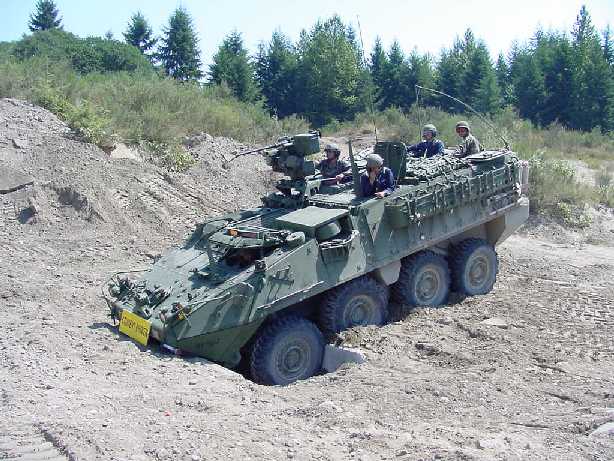
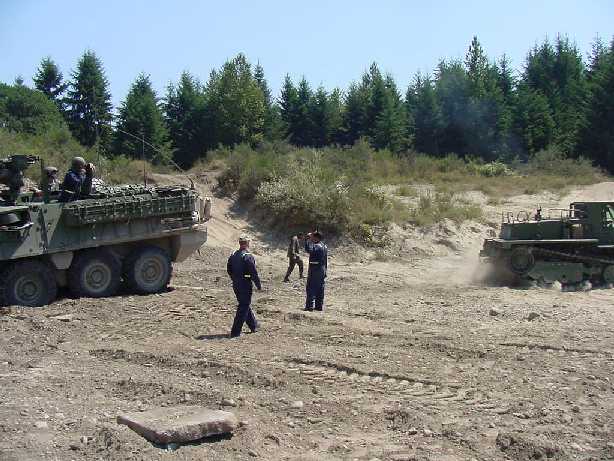
3. A large boat shape on tracks is too much to add extra armor outside to cover everywhere; underneath its difficult to attach plates without drilling holes that will let water; when you run over a land mine all of this metal compresses the explosion making it more deadly.
4. For land combat no more than one rifle squad and less than a dozen men should ever be in one armored vehicle; that vehicle should be armored with multiple layers to protect against RPGs and shrug off bomb blasts.
5. WHY pack vulnerable Amtracks with men and flammable ammo AND HIGH EXPLOSIVES when several where hit during invasion of Iraq at Nasiriyah resulting in dozens killed? Troops on top of SMALL tracked armored vehicles must not be surrounded by rockets, ammunition that if hull is penetrated will incinerate them; Extra ammo should be in trailers or strapped to outside near rear.
6. Why are inadequately protected Humvee 3-ton trucks leading 70-ton heavy tanks in the first place? Who made that decision?
7. Having only a few token LAV trucks with 25mm autocannon and tanks with 120mm guns is not enough firepower to smother a large area and asks crewmen inside to bear the brunt of all of the enemy's return fire, is it a wonder when they are knocked out?
8. Why are vehicles making U-turns in the face of enemy RPGs which exposes their weakest rear where engines and fuel tanks are? Why wasn't back up immediate action (IA) drills ready?
9. Why are we towing artillery that has to lob shells far away indiscriminately when Army armored self-propelled howitzers are available to drive up to specific buildings and just level them not neighborhoods?
10. Where are the tanks with mine rollers/plows to predet mines? If you don't have enough tanks you can't spare one to do mine roller/plow duty, and you end up losing tanks and killing men. Why are we not sealing the shoulders of roads with Rhino Snot and watching overhead with MANNED aircraft to prevent roadside bombs to be dug in? Where are the combat engineers?
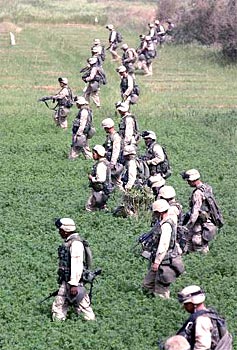
11. Why are marines looking for bombs with dozens of men on foot? Are we trying to help the enemy kill us so he can win a war of attrition?
12. Where is the tracked armored staying power of American marines to LIVE ON THE ROAD FROM SYRIA--because we are vulnerable on foot/trucks we cannot stay and rush back to base camps; when we leave the rebels take over; if we had containerized barracks we could dig in and "own" Iraqi territory and not have to invade people's homes.
13. We should establish an effective security fence like the Morice Line in Algeria and improved upon by the Israelis for years to keep outside terrorist fighters from entering Iraq. Sort of like what we need to do on our own borders in the U.S. for homeland security.
14. Working around weakness by throwing together handfuls of things is NOT COMBINING ARMS; combining arms involved capitalizing on American strength: armor and firepower. Armor must spearhead operations, not light infantry.
The USMC Bloated Amtrack Tradition of Failure Set To Continue with EFV
If the Iraq amtrack horrors are not enough, THE USMC WANTS ITS NEXT AMTRACK, THE EXPEDITIONARY FORCES VEHICLE OR "EFV" (used to be called the Advanced Amphibious Assault Vehicle) TO CARRY 20 MEN IN BACK!
Here is the typical USMC relive-WW2 dumbass in action.
First Mc author says we need to replace AAV7s because they stink, then he says they "performed well" in combat to prop up the USMC ego. Then he uses the chronological "1960s" technology hubris argument that wahhh we want a newer toy, the Army is getting new toys so we have to keep up with the Joneses.
Ignoring that crap to the heart of the matter, what he says is EXCERPT in " " and the FACTS are underneath.
LIFE IMITATES ART! LOOK WHO IS THE CURRENT EFV AMTRACK PROGRAM MANAGER!
Why its none other than the same Brogan who was pontificating on the need for a bloated amtrack back in 1995!
Brogan in 2005...
Philadelphia InquirerBrogan in 1995...
August 4, 2005
Pg. 1Vulnerable: Vehicle Lacks Armor In Undercarriage
By Joseph Tanfani, Tom Infield and Drew Brown, Inquirer Staff Writers
The marine vehicle that became the target for one of the worst military bombings in Iraq was built in a different time to fight a different kind of war.
Fourteen marines died yesterday while patrolling near the Syrian border in a Vietnam-era amphibious assault vehicle, designed to hit the beaches and roll inland.
With its lighter weight and an aluminum skin, the AAV is a floating war truck that provides less protection than the Army's rough equivalent, the Bradley Fighting Vehicle.
Critics say it was not designed for daily patrols over dangerous desert roadways.
"It is underpowered. It is essentially a big boat on land, and that makes it vulnerable," said Daniel Goure, a military analyst at the Lexington Institute, a policy group based in Alexandria, Va.
"It was never intended for these kind of missions. It was never designed for the kind of beating it has been getting."
Nearly all of the AAVs in Iraq were, before the war began, outfitted with add-on armor plates designed to stop the heaviest machine-gun fire or artillery shell coming in from the side, according to marine Col. Mike Brogan, program manager for the expeditionary fighting vehicle, the next-generation AAV.
It's called EAAK, pronounced "eek" - short for enhanced applique armor kit.
But, crucially, he said, the add-on kit does not cover the undercarriage, leaving the big tracked vehicles more vulnerable to mines or improvised explosive devices that come from underneath.
Although detailed information on yesterday's blast was unavailable, Brogan said marine casualties while riding in AAVs had typically been the result of "mine-type explosions."
The AAV, designed in the late 1960s and first used in 1972, has been showing its age. When another battalion of marines invaded Iraq from Kuwait in March 2003, at least a fifth of the vehicles broke down, overheated, or ran out of fuel.
But the AAV has been pressed into service, in Iraq, as a standard troop carrier.
One retired marine colonel with experience commanding AAV-equipped units in Somalia says they are effective in combat, with their .50-caliber machine guns and grenade launchers.
But he said the AAV was too big and unwieldy to serve as an Iraq patrol vehicle.
"I would never, ever do that," said the colonel, who asked for anonymity. "The AAV is more survivable than a humvee. But you're also going to kill a lot more marines if you get hit" with an improvised explosive device.
An AAV can carry 21 marines. The humvee typically holds four.
The marines are planning to build a faster, tougher landing craft called the Expeditionary Fighting Vehicle, but the program has been hamstrung by a series of budget cuts.
In 1994, millions of dollars were sliced from the program, causing a two-year delay; the latest defense budget delayed the program again, by another year. Now, the schedule calls for the first contract to be signed in October 2006. The first vehicles won't be produced for an additional 18 months.
The next vehicle will be designed more for prolonged land combat operations, Brogan said.
But even that version might not be strong enough to survive all improvised explosive devices.
"It would depend on the IED," Brogan said. "If it's just blast [from the side], we're going to do pretty well with that."
The Inquirer reported in April that the military's efforts to armor humvees and other vehicles were slowed by piecemeal funding, slow planning, and production that went in fits and starts.
Just two weeks ago, Congress added $340 million for the marine corps and $105 million for the Army for more armored vehicles, raising the total number of planned armored vehicles from several hundred at the start of the war to more than 10,000 now.
But Goure and other analysts say armor alone is not the answer. As the military forces in Iraq have improved the armoring of their vehicles, the insurgents have responded with bigger and more lethal bombs.
"There are not enough main battle tanks in the world to equip the forces in Iraq," he said. "There is no way to equip these forces to withstand a direct hit from a 1,000- to 2,000-pound IED."
EDITOR'S NOTE: Goure' is an idiot who never served a day in uniform. The Rhosedians/South Africans found a way to defeat landines, he should read "Taming the Land Mine" by Peter Stiff before he opens his ignorant mouth with defeatist, give-the-incompetent-status-quo-a-pass crap.
www.globalsecurity.org/military/library/report/1995/BMM.htm
Can We Afford The AAAV?
CSC 1995
Subject Area - Logistic
Author: Major M. M. Brogan, United States marine corps
EXCERPT:
"A frequently proffered alternative to the AAAV acquisition is procurement of a non-swimming IFV, such as the M-2A2/M-3A2 Bradley or the M-113A3, or the purchase of additional Light Armored Vehicles (LAV-25). Landing Craft Air Cushion (LCAC) would transport these IFV's to the shore."
FACT 1: M113A3 Gavin and LAV-1s do SWIM, not ship-to-shore but across lakes and rivers.
FACT 2: M113 Gavins can be fitted with a new nose and waterjets to swim in oceans, and when they land ashore they are not bloated targets. "AmphiGavins" by ARIS SPA of Italy www.geocities.com/armysappersforward/amphigavins.htm
EXCERPT:
"The Cost and Operational Effectiveness Analysis (COEA) prepared by the Center for Naval Analyses (CNA) specifically addressed this type of alternative. [27]
FACT 3: CNA is to the Navy what RAND is to USAF/Army; they tell their patrons what they want to hear; ie lies and BS.
EXCERPT:
"In preparing the COEA, CNA used the Department of the Navy Lift Study and assumed an over-the-horizon MEF amphibious assault, with one Regimental Combat Team as the surface assault element. The base case for the comparison, postulated moving this force and its equipment from ship to shore in AAV-7A1's and LCAC's.
The COEA compared 13 alternative systems (12 plus the base case): three slow- speed amphibians, a submersible vehicle, two high speed amphibians, five non- amphibious vehicles delivered by LCAC's, an LCAC-delivered surface assault with no armored vehicles, and a helicopter-delivered assault with only heavy equipment landing by LCAC."
FACT 4: COEA screwed up; did not look at LCACs delivering SWIMMING M113 Gavins to 4, 000 meter near shore positions and letting them swim the rest of the way to the beach saving much time compared to flying the LCAC all the way to the beach and then lowering ramp and driving M113 Gavins off
FACT 5: COEA did not look at option of HELICOPTERING IN M113 GAVINS AT 100+ mph
EXCERPT:
"To determine the most cost-effective weapon system, the COEA analyzed the following parameters: (1) The total LCAC loads to land the surface assault element of a MEF using the various systems under consideration; (2) The total time required to land the surface assault element ashore using a fixed quantity of LCAC's; (3) The percent of combat power delivered ashore as a function of time in each of the two previous cases; (4) A comparison of the effects these scenarios had on amphibious lift requirements, personnel requirements, and quantities of equipment.[28]
In each case, adopting a non-swimming armored vehicle required additional LCAC's or additional LCAC sorties to lift the assault echelon when compared to a self-deploying, high-speed AAAV."
FACT 6: COEA screwed up and did not look at all the options, study and conclusions are invalid
EXCERPT:
"Purchasing additional LCAC's to ferry the non-swimming vehicles adds hidden costs, the price of the LCAC's, to acquisition price of the armored vehicle."
FACT 7: M113 Gavins are available at zero cost to USMC. Converting to AmphiGavins and other capabilities would be only costs and far less than a brand new 30 mph water speed AAAV (EFV) of dubious bloated size to carry 20 men inside
EXCERPT:
"These cases also required additional amphibious ships (and Navy crews) to lift the LCAC's."
FACT 8: LCACs can be craned aboard sealift ships and interface with RO-RO ramps via floating causeway sections underneath to creat a docking platform. This is a huge myth USMC/Navy likes to foist on tax payers to get more amphib ships built while USMC force projection capabilities never grows as we replace old ships with new ships 1-for-1 or less.
EXCERPT:
"Finally, because the troop payload of all of the non-swimming, armored vehicles is less than the AAAV, this alternative requires more infantry fighting vehicles and more vehicle crewman. It also requires a compensatory reduction somewhere else in the marine corps's end-strength."
FACT 9: here again the USMC fatal laziness is revealed. A bloated 20 person amtrack IS TACTICALLY UNSOUND ON LAND. It is a fatal mistake. USMC anti-mechanoia is absurd. Better to have two small M113 Gavins carrying two rifle squads at the cost of 4 crewmen than 1 huge AAAV (EFV) carrying both rifle squads as a huge target at the cost of 2-3 crewmen. 3 crewmen if overly large 30mm autocannon turret is used. No manpower complaints heard from USMC about the extra foot slogger taken away to be a 30mm gunner in the EFV turret.
FACT 10: Smaller M113 AmphiGavins would be able to FLY by both CH-53E/HLR helicopters, C-130s far inland at 100 mph--which is 4 times the speed of the overly complex AAAV (EFV).
EXCERPT:
"This is not to say that the Bradley and the other non-swimming candidates are not good armored vehicles. They excel performing the missions for which they were designed, but they are not suited to play a major role in amphibious assaults."
FACT 11: the smug USMC pronouncement here is disgusting. Bradleys and Gavins are far more SOUND land combat vehicles. What's the point of an AAAV if after it reaches shore it only get destroyed killing everyone inside?
FACT 12: the Gavin IS DESIGNED to fly by aircraft which means it can play a role in amphibious assaults.
FACT 13: the Gavin CAN SWIM to include ocean swimming with the "AmphiGavin" waterjets and nose to play a role in near and OTH amphibious assaults via LCAC or helicopters etc.
FACT 14: LARGE NUMBERS of medium Bradleys and even M1 Abram heavy tanks CAN play a role in amphibious assaults is USMC would get off its ass and pursue the sealift ship/LCAC interface. The stupidity and narrow mindedness of the USMC that it must have a swimming amtrack in a technological advancement and perpetuation of WW2 beach assaults is appalling.
EXCERPT:
"The greatest problem with doing an operation entirely by air is that after arriving in the landing zone, the helicopters depart and the infantryman is left to his own devices."
FACT 15: NOT TRUE. HELICOPTERS CAN DELIVER LIGHT TRACKED ARMORED FIGHTING VEHICLES SO INFANTRY IS NOT LEFT TO ITS OWN MAN-PACKED DEVICES.
EXCERPT:
"What he can carry on his back limits how far and how fast he can march. Clearly, he no longer has battlefield mobility anywhere near that provided him by an armored, tracked vehicle, and he will be hard-pressed to develop the high tempo of operations contemplated in maneuver warfare."
FACT 15: AMEN! The first true thing he has said so far!
EXCERPT:
"The marine corps must also determine that if it is going to perform only helicopter-borne operations, then maybe the nation no longer needs Marines. After all, pundits will argue that the Army has units dedicated to helicopter-borne assaults and has even conducted them from aboard ship as we saw during Operation RESTORE DEMOCRACY in Haiti. The marine corps certainly does not want to be in the unenviable position of defending its existence if it no longer possesses the capability to conduct surface-borne amphibious assaults."
EXCERPT:
"The AAAV will help ensure the success of what military writers often refer to as the most complex operation, the amphibious assault, by making the movement of the assault forces from amphibious shipping to objectives ashore a seamless operation."
FACT 17: the parachute or airland operation is FAR MORE COMPLEX than an amphibious assault. USMC egomania and braggadocio notwithstanding.
FACT 18: how will AAAVs trying to swim at 30 mph from 25 MILES out going to make a "seamless" operation when they break down and are stranded in the water? Who will rescue them?
EXCERPT:
"With the draw down of the U.S. armed forces, it is likely that even in those instances where the marine corps provides an enabling force to allow the introduction of the Army"
FACT 19: Army Airborne at 300-500 mph in USAF planes will get there first with airborne forced entry unless USMC MEU happens to be nearby which is not likely ie; Grenada, Panama, Iraq, Afghanistan
EXCERPT:
Unlike previous amphibious vehicles, the AAAV is being managed by a marine corps Program Office, the Direct Reporting Program Manager for Advanced Amphibious Assault (DRPM AAA).[33] The program manager, a marine Colonel reports to the Assistant Secretary of the Navy for Research, Development and Acquisition. Because of this high level of scrutiny, and because of the projected costs [34], the AAAV is much more visible than the previous amphibious vehicle programs managed from within the Naval Sea Systems Command.
FACT 20: Oh, joy! A moron like the "Can We Afford The AAAV?" author in charge. Is it a wonder its 2005 and there is no "AAAV" eh, "EFV" and marines are getting incinerated in AAV7s in Iraq?
EXCERPT:
"The AAAV will be "one of the most all-around credible weapons systems in the world. It will be capable of contributing, surviving, and winning on the battlefield of the 21st century."
FACT 21: the fundamental size parameters of the AAAV/EFV to carry 20 men is unsound and makes it unsurvivable on today's non-linear battlefield which are dominated by high explosive weapons like RPGs, ATGMs and roadside bombs. The AAAV/EFV is a high cost deathtrap like its predecessors all because USMC was lazy and wanted to cram too many men inside one vehicle.
So not only is the USMC stupidly making the same bloated amtrack mistakes of the past, its compounding error by making the Army's Bradley Infantry Fighting Vehicle mistake by placing an overly large 2-man 30mm autocannon turret on the EFV, which will "smother" the infantry in back. Though a stablized, shoot-on-the-move autocannon is necessary and good, it should only be a small 1-man turret size so the infantry in back can see well enough so the dismounting platoon leader or platoon sergeant can command the vehicle from there or an adjacent hatch like the AAV7 or AIFV has. If dismount leaders are stuck in 2-man turrets they will not dismount to effectively lead troops for dismounted maneuvers. What's worse fears that the powerful 2-man turret could swing into the troops in back standing up in back could make risk-averse officials to order them to "button up" robbing us of 360 dgree all around security observation/fires to prevent fatal RPG and roadside bomb ambushes.
A Smaller Amphibious Tank is Needed and Has been Offered to USMC
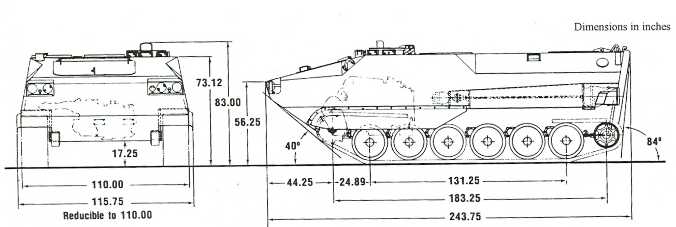
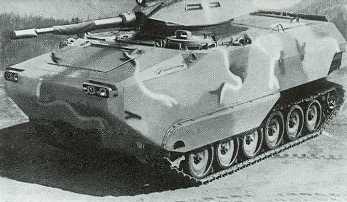
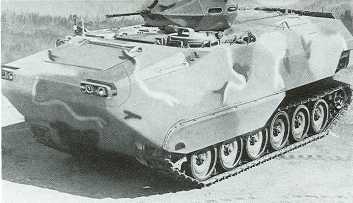
Hunnicutt, "Bradley: a History of American Fighting and Support Vehicles" states on page 359:
"A number of concepts were studied for application to the LVT(X) requirement. FMC also proposed a vehicle based upon components of the M113A2 [Gavin] armored personnel carrier. It was intended to carry a squad size unit from ship-to-shore and on to the final objective. Although it was small and did not meet the 10 miles per hour water speed requirement of the LVT(X), it could be armed with a variety of weapons and serve both as an assault landing vehicle and as a land fighting vehicle. Dubbed the LVT assault personnel carrier, it was intended to serve as the basis of a family of vehicles. Assembled from aluminum alloy armor plate, the proposed LVT assault personnel carrier was to be manned by a crew of two and carry a 13-man squad in the rear compartment. The hydraulically operated rear ramp had a door for personnel and a cargo hatch was located over the rear compartment. The driver was in the left front and the vehicle commander was in the cupola. The latter could be anything from the M113Al type cupola with an externally mounted .50 caliber machine gun to a one-man weapon station armed with a .50 caliber machine gun or a 25mm Bushmaster cannon. The vehicle was to be powered by the 300 horsepower 6V53T diesel engine using the Allison TXlOO-1A transmission with a hydrostatic steering differential. The M113A2 suspension was used on the lengthened vehicle with six road wheels per side [MTVL]. It rode on 17 inch wide tracks. When afloat, the vehicle was propelled by two water-jets powered by two fixed displacement hydraulic motors driven by the hydrostatic steering pump. This arrangement eliminated the need for drive shafts and gear boxes in the crew compartment. The tracks and water-jets could be operated simultaneously. Combat loaded, the estimated weight was about 33,000 pounds including a 5,000 payload. The maximum speed was expected to be 38 miles per hour on land and 7 miles per hour in water with a cruising range on roads of about 300 miles.A larger, two-man, turret also was proposed for installation on the hull of the LVT assault personnel carrier. Armed with a 90mm Cockerill cannon and a coaxial 7.62mm [medium] machine gun, the turret also had an external mount for an additional 7.62mm machine gun at the commander's hatch. Eight 90mm ready rounds were stowed in the turret with an additional 32 rounds in the hull. The crew now consisted of the driver in the left front hull with the commander and the loader in the turret. Six squad members also could be accommodated in the rear compartment."
Enter the M113 AmphiGavin!
Since the '80s when the USMC foolishly did not buy the sound LVT concept that could also be FLOWN BY CH-53E Super Stallion heavy lift helicopters (external sling load) for Air Assaults and C-130 fixed-wing turboprop STOL transports for 3D maneuver, ARIS SPA of Italy has created the "ARIS GATOR" waterjets and nose kit that can be applied to ANY M113 Gavin to make it a ship-to-shore "AmphiGavin". Details:
www.geocities.com/armysappersforward/amphigavins.htm
If the USMC were wise it would cancel the EFV boondoggle made by corrupt GDLS (the fools who bring us Stryker truck deathtraps) and obtain hundreds of M113 Gavins, stretch their hulls into MTVLs, use 600 hp hybrid-electric drives, band tracks and fit waterjets and a new nose to them to be their AmphiGavins, that would be fully armored, stealthy and fast ship-to-shore as well as inland maneuver warfare platforms. They could even be fitted with reasonable 1-man autocannon turrets and gunshields for the troops in back not unlike how some Army LVT4s were in WW2. Firing ports from retrofitting new hatches and doors IN ADDITION TO top gunshields are also an easy to do possibility to get suppressive fire from the mounted infantry to deter ambushes when moving mounted.
GOOD IDEA IN 1945...
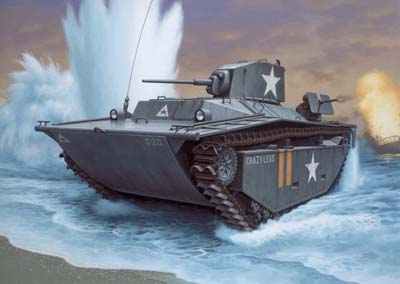
A GREAT IDEA FOR 2007...AND BEYOND!
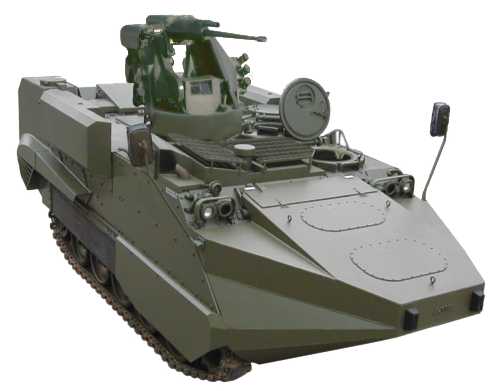
Special Operations: Iowa Class Battleships heavy armor protection, firepower + AmphiGavins/Heavy Lift Helicopters = Decisive 3D Maneuver

America's four Iowa class battleships, the USS Iowa, USS New Jersey, USS Missouri and USS Wisconsin should be immediately recalled to duty on a reserve status, two BBs on each coast. Iowas can transit the Panama Canal unlike our bloated supercarriers. Our BBs are the only heavily armored surface ships we have that can survive in the face of enemy surveillance strike complex (SSC) fires. If we don't want to be driven from the surface of the sea, we need to return to a "gunboat" diplomacy that has "gunboats" not floating airfields with potential victims and hostages.
Our BBs should be upgraded into "BBG-21" configuration with two long flight decks and ski jumps to operate F-35B STOVL aircraft to provide their own air cover as well as insert/extract SOF commandos using GRIER pods.
To deliver better combat power than just foot sloggers, heavy lift helicopters like the CH-53E/K Super Stallion and CH-47F Chinook can deliver both Mini-Gavins which are reduced in size to roll-on/off from the former's rear ramps and AmphiGavins full-size using external sling loading or if they are Mini-AmphiGavins from inside.
MINI-GAVINS
The Mini-Gavin is a superior American version of the German Wiesel concept of a helicopter air-transportable tracked AFV in that its lake/river amphibious and uses proven M113 components.
The Iowa class rear deck area is very spacious as-is to operate even large heavy lift helicopters. It will be even larger with BBG-21 mods.
AMPHIGAVINS
The regular sized or mini- sized M113 Gavin can be made into the ARIS SPA waterjet and nose equipped "AmphiGavin" that can swim from ship-to-shore in oceans. In the following pictures we show AmphiGavins loading into heavy lift helicopters which can drop them off into the water to swim the rest of the way to shore or take them inland themselves. Keeping the enemy guessing and unable to react by having many deployment options is the epitome of "maneuver warfare". A stern ramp could be developed so AmphiGavins could drive into the water from the Iowa class BBG-21 to swim to shore.
SPEEDCRANE
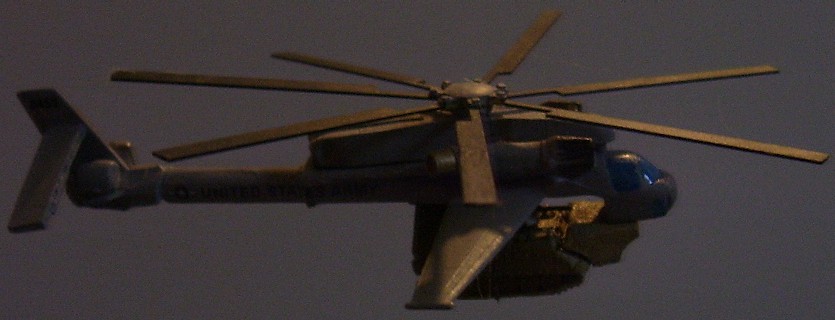
The sad truth is that conventional helicopters do not fly fast enough to survive on the increasingly missile dominated non-linear battlefield (NLB). Its high time that particularly U.S. Army Aviation wake up and stop making c'est la guerre excuses for their constant failures to improve their V/STOL flight capabilities has resulted in preventable shoot-downs and death over Iraq/Afghanistan. A great place to start would be with buying a batch of 50 x Erickson AirCrane helicopters and modifying them to be "SpeedCranes" to fly at 250+ mph with 20 ton loads. Another vital improvement would be to develop "SpeedChinook" kits for our CH-47 helicopters so they can not only air-mech Mini-Gavins faster but can deliver troops to pre-positioned shipping sets at sea to expedite their off-loading.
The possibilities an ocean-swim capable M113A3 AmphiGavin provide are exciting and only limited by your imagination to achieve surprise over the enemy. The EFV needs to be cancelled.
www.vtol.org/news/issues1004.html
Marine Corps Outlines CH-53 Heavy Lift ReplacementWith an Operational Requirements Document awaiting the signature of the Commander of Fleet Forces Command, the U.S. marine corps is moving toward a Milestone B launch decision on the CH-53 Heavy Lift Replacement (HLR) program in early 2005. The program is now aimed at 154 new-build CH-53 helicopters with first flight in Fiscal 2011, full-rate production decision in Fiscal 2013, and Initial Operational Capability in Fiscal 2015.
Separate from the Army-led Joint Heavy Lift concept studies, the marine HLR has a threshold requirement to carry 27,000 lb over 110 nm unrefueled with a 3,000 ft, 91.5 F density altitude; the objective load is 30,000 lb over the same distance. The payload is equivalent to two heavy High Mobility Multi-Purpose Wheeled Vehicles or the latest configurations of the Light Amphibious Vehicle. The totally new HLR will increase current CH-53 gross weight from 74,000 lb to 82,000 lb. At the same time, it provides an opportunity to roll back the high operating and support costs of the CH-53E with new technology.
The CH-53 HLR is now envisioned with a totally new fuselage 12 in. wider than that of the CH-53E to accommodate C-130-size cargo pallets without repacking. Longer, higher sponsons will eliminate the jettisonable tanks usually carried by CH-53Es and give the new helicopter the same fuel capacity with no increase in shipboard footprint. Fly-by-wire flight controls promise to reduce empty weight and enhance survivability. An integrated "glass" cockpit is meant to reduce crew workload and provide joint-service digital interconnectivity.
The conceptual CH-53 HLR will have three new 6,000 shp-class turboshafts driving a new split-torque gearbox. Constrained by the dimensions of existing LHA and LHD amphibious assault ships, the CH- 53 HLR will have the same main and tail rotor diameters of the CH- 53E, but it will exploit broader-chord rotor blades with advanced airfoils to hike performance. The current concept has a 79 ft diameter main rotor with 6% greater blade chord and a 20 ft diameter tail rotor with 5% greater chord. A new rotorhead with dry elastomeric bearings is expected to cut maintenance costs and last the life of the aircraft.
The marines have considered mid-life upgrades for the CH-53E since 1992 and with the extraordinary operational tempo in Iraq, Afghanistan, and elsewhere face both high operating and support costs and the impending retirement of Super Stallion airframes. A comprehensive Analysis of Alternatives completed in 2003 considered the cost and schedule history of U.S. Department of Defense aircraft remanufacturing programs. It concluded a new-build HLR program provides least risk. The marine Corps recently found the cost of remanufacturing UH-1Ns to UH-1Ys comes within 1% of the cost of a totally new helicopter and removes needed aircraft from the fleet for two to three years.
*********************
What CH-53 HLR means is that AmphiGavins could be carried INSIDE and roll-on/off for "heliborne" (USMC terminology) air assaults from ship-to-shore (STS). The 1/3 of a BLT that lands by helicopters need not be out maneuvered and out-gunned because it can only foot slog. The USMC could have "Air-Mech-Strike" capabilities TODAY at a fraction of the costs of EFV R&D that yields nothing.
Its not too late for the USMC to learn from its bloated amtrack past and field the world's greatest amphibious infantry-carrying tank!
Why doesn't the USMC Start Over?
Former USMC tanker, Mark Ash has some great concepts if the USMC were to drop EFV and start over:
Mark writes:
"First off, the USMC needs to realize that the days of the high troop capacity LVT are over. They need an Amphibious Infantry fighting vehicle to carry one (1) squad of infantrymen. One Squad rarely exceeds 14 men. A marine rifle platoon has 3 such squads. Current AAV platoon structure is 3 sections of four vehicles. This is misleading as only three vehicles in each section actually carry grunts. One of the others carries the AAV PLT OIC, Infantry CO and fire support team (and of course your friendly AAV RO or radio repairmen). One of the other spare AAVs carries the AAV Plt Sgt, Corpsmen, Maintenance chief and acts as a Log. vehicle for the Plt. The last vehicle carries whatever mortars or ATGW available to the Infantry Co.
What I say happens is you build an AIFV with a 14 to 17 troops capacity and have an AAV platoon of 14 (AAAV-EFV is already planning a Plt of this size). You would still have the 9 AAVs needed for the rifle squads. You would have one to carry the FST/FOs, one to be the general log vehicle, 2 as purpose build 120 mm mortar vehicles and 1 to carry dismounted machine gunners and ATGWs. If you have a capacity of 17 then you could have a two-man machine gun or ATGW team per vehicle.
Because your not stupid and you realize a vehicle traveling at 15 to 18 mph riding low in the water is harder to spot then a vehicle screaming along at 25+ mph skimming the surface and causing a considerable wake. So you don't need an engine that big. You also realize you can use a HED (or at least an electric transmission, that have been around for a long, long time) so the vehicle is less mechanically complex. You then design it for a minimum use of hydraulics. You retain the 30mm cannon, but in an overhead weapon station (OWS UA-under armor), that also mounts a 7.62mm and Javelin ATGWs. You also provide armor to shield the OWS from damage and provide hatches so the gunner can check on any problems with the weapon station. Instead of all your road wheels retracting on at a time, you mount the whole suspension on a frame and retract that, though not all the way into the hull. You have a hinged flap that folds out from the bottom of the hull over the tracks to reduce drag and joins with the armored. You also make it so this hinged flap can be released in emergencies and even with hydraulic failure you will still be able to use the tracks. Even with all this you end up with a vehicle that is smaller then the AAAV-EFV and wouldn't be any larger then the current AAVP7A1 (size wise that is, it would weigh between the AAVP71 and AAAV-EFV, because it would be better protected then either one). It would also be lower then those two vehicles.
Modify the hull by further by lowering the roof and using it for the basis for the Amphibious Gun System, SPG and SPADA. The AIFV would be the basis for the Mortar and Amphibious ABV.
I don't like HLCACs, V-22 Osprey or the AAAV-EFV, however just because the Navy/marines seem to be at a loss on how to prepare for OMS doesn't mean you can't do it. They went a step further away when the canceled Textron's new LCU design. That would have filled the need for transporting the second wave (that could be conventional forces) to the beach instead of the LCAC. Sure the LCAC is fast, but it lacks capacity. The V-22 and AAAV-EFV are both deathtraps and both should be replace with better programs. Tilt-rotor aircraft can work, you just need to move the engines to center mass and run everything from the drive shaft that is already in place. I would also go with four smaller engines, two on a front wing and two on a back wing. For the AAAV-EFV, that's GDLS screwing the USMC. You don't need vehicles that can go 25 to 29 mph in the water, just something that can go between 15 to 18 mph. You need a much more reliable vehicle and you need some of those vehicles to be Gun Systems, Artillery and Assault Breacher Vehicles.
You don't need heavier aircraft for you Carriers, you need a new purpose built fighter. Something like the YF-23 (as I abhorred the F-22). You also should modify some old Spruance and Kidd Class DDs with the 8" Gun they tested on USS Hull (or Crusader/PzH2000 turret like the Germans are testing). Also convert some of now canceled LCU(R)s to gunships with 30mm cannons, two 120mm EFFS/Dragon Fire mortars, a Crusader or PzH 2000 type turrets or MLRS turret (alternate between these two). I would top this all of with a Navalized version of the Commanche, but armed with a 30mm cannon.
You don't want to get anything larger then a landing craft within LOS of the shore. For Carriers I would go with something between the size of the Nimitz and Tarawa/Wasp-class ships, then get rid of the fore mentioned types. You could have more carriers. Right now if one carrier gets hit the show is off. I would have San Antonio-class sized ships and smaller LSDs to carry my Amphibious mechinized force. No more 'one carrier' battle groups. No more 'One-size-fits-all' half-assed carrier/amphib ships. Either they carry aircraft (and can carry all types need) or they carry the amphibious force.
And the whole idea of OMS is so you can pick landing sights of your choice, not the enemies choice. We also need vehicles that withstand RPG (and the next size up of AT weapons) attacks. You also need mechanized airborne forces, as OMS (or 2D armored maneuver from the sea) needs 3D maneuver. Just as a successful 3D mech maneuver would need 2D Armored Maneuver to support it. At worse one would cause a distraction for the other allowing it to succeed, at best both would succeed well. Try to do this with current Airborne and marine forces (or forces with the AAAV-EFV) and you would fail miserably."
Meet the "New" bloated EFV: the marine Iwo Jima re-enactment victimology clubs's genetic defect of trying to cram too many men into too large a vehicle to get ashore is a very unsound practice since HEIGHT is the #1 visual give-away on the non-linear battlefield.
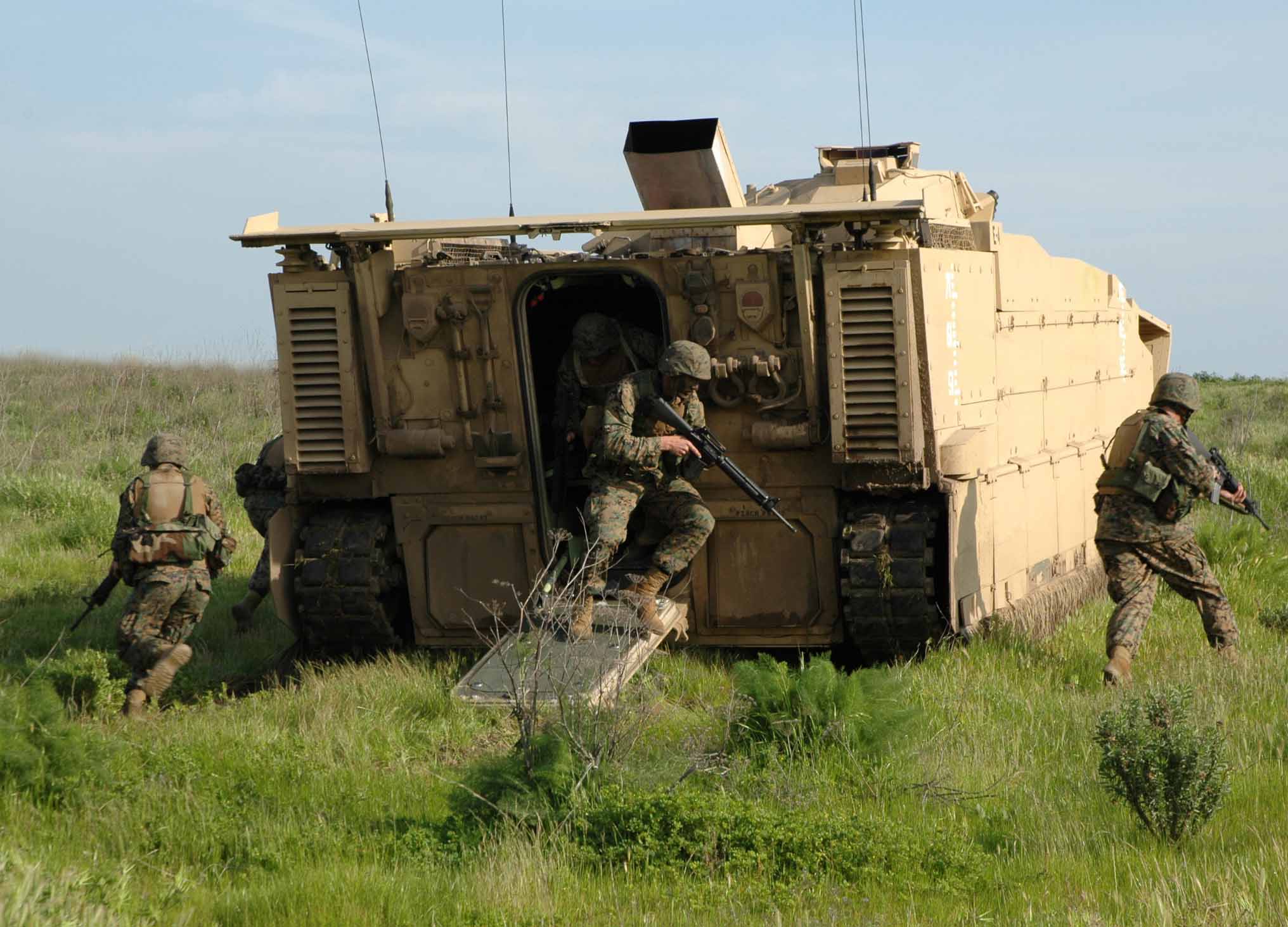
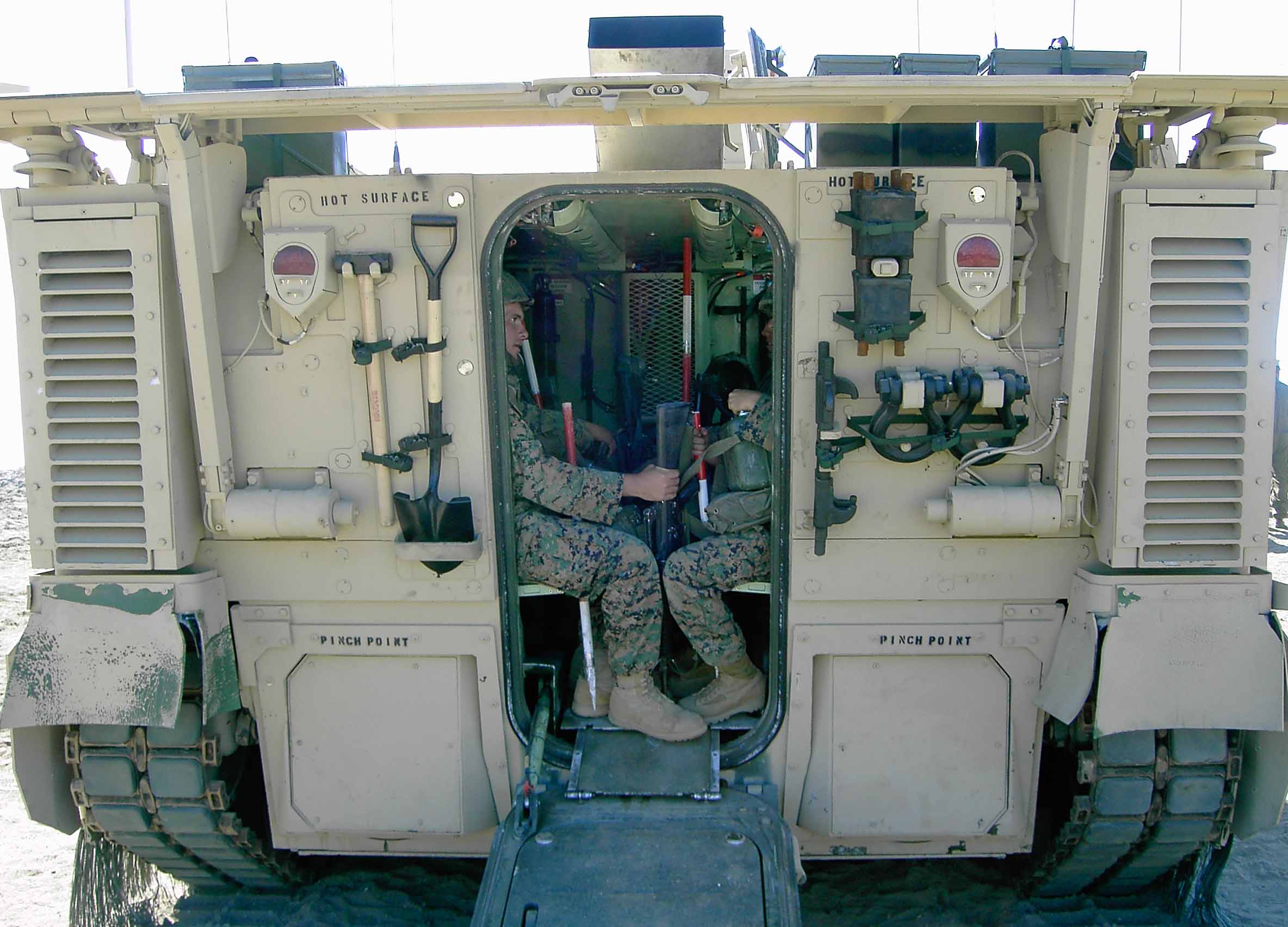
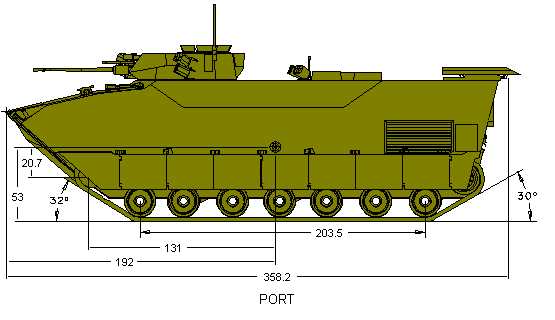
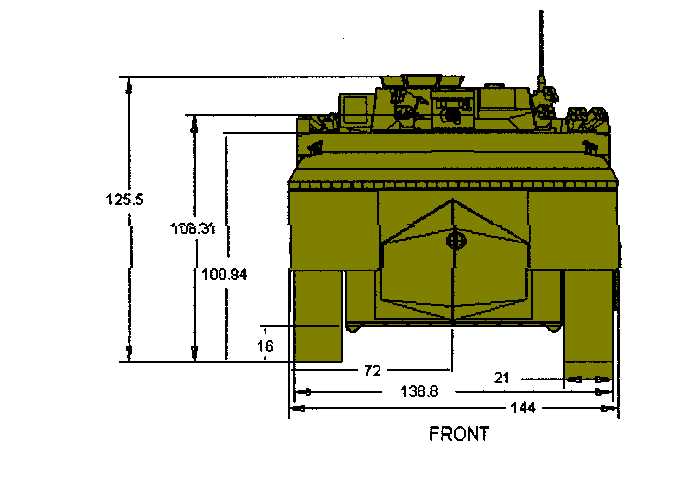
Read USMC officers who oppose it:
www.fas.org/man/dod-101/sys/land/aaav.htm
EFV is 358.2 inches long by 144 inches wide
M113 Gavin is 207 inches long by 105 inches wide at hull (98 inches at tracks)
AmphiGavin nose section folds up or detaches completely.
Caveat: for simplicity to make comparisons, we do not factor in the separation distance to chain down vehicles.
Length
One M113 Gavin takes up only 207 inches of EFV length, leaving 151.2 inches. Add a second M113 Gavin lengthwise and for just 55.8 inches you get a second Gavin in space of just one EFV. Essentially you get two Gavins for every EFV.
Width
One M113 Gavin takes up only 105 inches of EFV width, so two Gavins at 210 inches of width only require 56 extra inches to get a double row.
Bottom Line:
Typical amtrack load in a MEU is 12.
Single-row you get two M113 Gavins for every EFV. You also free up 19 inches of width. That's 24 x Gavins instead of 12 x EFVs. 24 x 30mm autocannon delivering 312 infantry to the EFV's 12 x 30mm autocanon and 216 men. That's right--the liars at GDLS to make the EFV appear less bloated are saying only 18 dismounts can be carried instead of 20. Fine, live by a lie, die by a lie.
You need 670.6 inches of extra length to get 24 Gavins compared to 12 x EFVs; but you gain 456 inches of width, so actual extra deck space needed is 214.6 inches. If you cannot cough up a pair of BS, flimsy 180 inch Humvee trucks (typical amphib ship is packed with 100+ of these targets), then go with 22 Gavins--still beats 12 EFVs.
Double-row: you get two Gavins width-wise for every EFV with 56 inches of extra width required. This means you get 6 x Gavins (621 inches of length) in the space of every two EFVs (716.4 inches long) with 95.6 inches of length extra gained for more Gavins etc.
If you want to be real anal retentive and narrow-minded as a typical Navy/marine contrarian, look at it like all you had to work with was the space of two rows of 6 EFVs. What is good for the goose, is good for the gander, right? Floor space is floor space, right? Except when its for something the Navy/marine status quo doesn't like, then "complications will arise" and ship loading is too convuluted with too many variables for anyone to question the wisdom of the Navy/marine egomaniacs etc. etc. ad nauseum. Let's continue anyway.
2 rows of 6 x EFVs is 288 inches wide and 2, 149.2 inches long not counting separation space to chain vehicles down. Not utilizing the ability to get 3 x Gavins wide at a small deck space cost of 37 inches for 179.1 feet, lets see what we get by just two rows of Gavins which gains us 78 inches of width for 179.1 feet.
In that 179.1 foot length of 6 x EFVs you 10.38 x Gavins, or almost 11. Obviously you would use that space for an 11th Gavin at a small space cost of .62 of a Gavin's length. But since we are dealing with USMC/Navy nat-sayers who lust to continue to operate bloated amtracks to their fiery deaths, we close with the reality that in LESS SPACE than what it takes to embark 12 x EFVs we can get 20 x M113 AmphiGavins or Gavins. If you are realistic and take up 37 more inches for a 3rd row of Gavins you get 30 x Gavins instead of just 12 x EFVs. If you use up .62 of a Gavin's length to make the rows get an 11th Gavin, this means 33 x Gavins.
33 x Gavins means 33 x 30mm autocannon and the option for ATGMs, 120mm mortars, 106mm recoilless rifles and a host of weaponry and combat engineer means like Hobart's "Funnies". Its "funny" that the marines boast that they are here to force an entry yet have not invested in the mechanized means to do it well, choosing instead to throw men's bodies against inter-locking machine gun fire, barbed wire and obstacles. 33 x Gavins mean 429 men can come ashore to dismount after the obstacles have been breached---compared to just 216 in EFVs.
Its clear you can get 2x and actually 3x the Gavins in the deck space of every bloated, tactically unsound EFV. Oh, yes 2-3 Gavins each powered by 300 hp diesel engines they use far less fuel than one 850 hp EFV to go 300 miles. And yes, if powered by 600 hp hybrid electric drives Gavins burn even less fuel and go twice as far--600 miles.
Summary
BOTTOM LINE USMC AMTRACK OPTIONS:
1 x 30-ton high-water speed, complex, expensive, new design EFV = 3 crewmen + 20 dismounts (1 x 30mm autocannon)
vs.
1 x 30-ton low-water speed, simple, affordable, new design AAV2000 = 3 crewmen + 18 dismounts (1 x 30mm autocannon)
vs.
2 x 15 ton low-water speed, simple, affordable, existing design M113 AmphiGavins = 4 crewmen + 26 dismounts (2 x 30mm autocannon)
EFV OPTION
Big, bloated target. Costly. Unsafe to swim at 30 mph for 20-25 miles off-shore. Cannot do 3D maneuver from ships or from aircraft smaller than C-17. 2 ways to get self to shore and do OTH movements:
1. Under own power via high water speed @ 30 mph
2. By LCAC drop-off @ 60 mph
AAV-2000 OPTION
USMC could have a new design AAV-2000 (Mark Ash) that could carry 18 troops, 3 crewmen, 45-60 mph road speed, hybrid electric drive stealth and a 30mm cannon smaller and cheaper then the EFV if they go for a more modest water speed; if they want to do OTH assaults ferry them close to shore by LCACs and drop off to do final 4, 000 meters run-in on their own. Cannot do 3D maneuver from ships or from aircraft smaller than C-17. 2 ways to get to shore and 1 way to do OTH:
1. Swim self to shore at 10 mph
2. OTH maneuver by LCAC @ 60 mph for 4 km drop-off or all the way to beach
M113 AmphiGavin OPTION
Cut the troop requirement down to 13-15 and we're even better off by basing it on (ARIS SPA "ArisGator") M113 AmphiGavins (Mike Sparks/Carlton Meyer concept) with high technology hybrid electric drive and band tracks as options. 2 x AmphiGavins for every larger EFV or AAV-2000 means more men delivered and 2x the 30mm autocannon firepower. AmphiGavins can get to shore in 5 ways---if USMC wants to do OTH assaults and OMFTS they can FLY over sea mines and obstacles and strike deep inland using smaller M113 AmphiGavins in 4 different ways:
1. From amphibious and/or sealift ships swim selves to shore at 10 mph
2. Go ashore by LCAC @ 60 mph for 4km drop-off or all the way to beach
3. Inland from 1-100 kilometers by CH-53E (external sling-load)/HLR (external or internal load) Super Stallion heavy lift helicopters @ 100/150 mph
4. Inland to any distance via C-130 Hercules @ 300-400 mph airdrop/STOL airland
5. To any water body or any distance inland from a new seaplane transport amphibian @ 300-500 mph; airland into the water or on land.
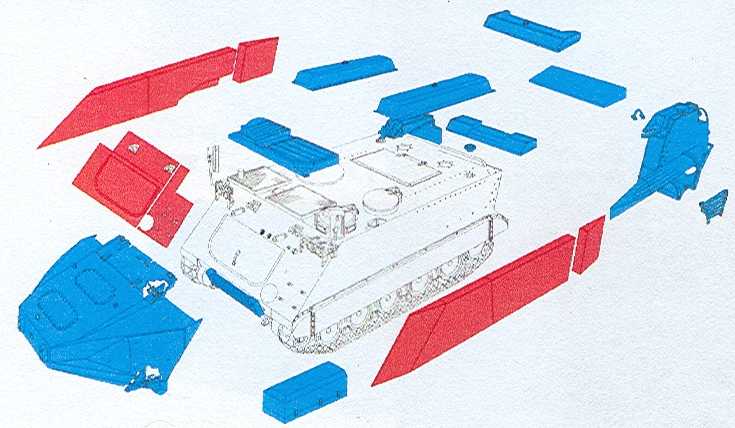
The AmphiGavin's front nose overhang is very small but can be REMOVED for land operations. Clearly the USMC M113 AmphiGavin is the best future warfare option delivering the most men, most firepower via the most maneuver options with the best armor protection, yet at the lowest costs.
Amphibious "male" big gun tanks: Lower the River or Raise the Bridge?
Lower the River?
As you now see, the best option for the USMC to get an infantry carrying, amphibious tank is the M113 AmphiGavin. A 20-40mm autocannon could be fitted on top for "female" tank smothering effects without being too high or heavy to roll on/off from inside the CH-53 HLR or be externally slung by smaller fuselage CH-53Es.
To get bigger "male" firepower without being too high/heavy for helicopter transport, the 106mm recoilless rifle and/or 2.75 inch Hydra 70mm rockets are the best options. To reload however, men will have to expose themselves to enemy fire unless new turrets are developed.
Raise the Bridge?
Another option would be to fit 20-40mm and 90-120mm gun turrets on M113 AmphiGavins just like the CHICOM PT76 variants do, and have them swim themselves to shore. To do air-mech movements, we'd GET A BIGGER HEAVY LIFT HELICOPTER than even the CH-53 HLR. Seabasing advocates want a 20-ton V/TOL lifter, anyway. The problem with the CH-53 is its FUSELAGE which results in a loss of 6 tons of lift. If we went with a skeletal SkyCrane type heavy light helicopter arrangement as the CH-53E was originally supposed to be, oversived light-to-medium sized tracked tanks with turrets like the M8 Buford/Thunderbolt/Tracer Armored Gun Systems could be easily carried for heliborne air assaults/3D maneuvers. Details:
www.combatreform.org/nextchinook.htm
When we say "easily" we mean that while up-engined CH-53 HLRs could carry these light to medium tanks, when high/hot weather conditions reduce lift, there will be many times that they cannot fly the male tanks to shore, By economizing on the aircraft body to maximize lift in a SkyCrane design, air-meching light to medium tanks can be viable under more atmospheric conditions to enhance warfighting.
Why Swim at all when you can fly from ship-to-shore?
There are two other schools of thought worthy of mention that do not advocate bloated amtracks.
The mini-tracked Armored Fighting Vehicle or "tankette" school of thought (Jarnot/Meyer) proposes under 10-ton vehicles that cannot swim from ship-to-shore but are easily helicopter transportable at 100+ mph in large numbers and the swarms of medium-weight AFVs delivered by USN LCAC school of thought exploiting the hovercraft landing craft's ability to fly them 8 feet above the water at 60 mph so we have at least 3 vehicles armored enough to prevail against RPGs, roadside bombs and can kill enemy heavy tanks and bust buildings (Macregor) per sortie.
The candidates for the tankette air-mech option are the German Wiesel, Swedish Bv206S and the American reduced "M113 1/2" Gavin called the Lynx. Details of how to Air Assault light tanks are covered on the web page below:
The USMC has in the past been successful with helicopter-transportable tankettes like the M50 Ontos for amphibious and inland combats but strangely when they retired them, did not replace them to keep and improve on the capability. Tankettes will find it difficult to stay on top of the RPG and roadside bomb threats since they don't have enough payload/size to work with (they are too small in opposite contrast to bloated amtracks that are too BIG), but its still far better than air-delivering foot sloggers without ANY armored mobility and firepower.
The non-swimming medium-weight tanks delivered by LCAC option en masse would not only prevail on land it would not be so different from what the USMC does now with its M1 Abrams heavy tanks when landing ashore. However, when the LCAC's bow ramp lowered, 3 x M8 Buford/Thunderbolt/Tracer medium tanks with add-on armor roll off---3 killing platforms with space in back for 4 troops---instead of just 1 Abrams that cannot carry any troops. If CH-53 HLRs or SkyCrane helicopters with adequate lift are obtained, these medium weight tanks can also be flown ashore as noted earlier.
The drawbacks of using non ship-to-shore swimming tanks is that inland there are rivers and lakes to cross. One caveat is that the Bv206S tankette can swim across lakes/rivers but not in the surf zone. The British Royal Marines use an enlarged Bv206S version called the BV10S which might sway the USMC to copycat what they do to gain an air-mech 3D maneuver capability. The 3 rivers the USMC could not cross in a timely manner during OIF because 75% of their force was in Humvee/larger trucks and M1 Abrams tanks that could not swim contributed to their 6-day delay in arriving into east Baghdad as the U.S. Army's 3rd Infantry division waited in western Baghad for them. During this 6 day delay, Saddam and his loyalists escaped with enormous supplies of explosives and artillery shells to wage guerrilla non-linear war which continues to the present and so far has cost us over 1, 600 dead and 19, 000 wounded Americans. The consequences of not being able to decisively maneuver to include crossing water obstacles can be fatal. In the tankette and medium weight tank swarm options, helicopters could fly them over lakes/rivers to keep maneuver momentum.
Conclusion
The one thing that is clear from all of these facts, is that there are many far better options for the USMC to go STS and do OMFTS than proceeding with the troubled EFV bloated amtrack boondoggle. The point may be moot as the latest reports are that the EFV cannot float if it stops moving forward in the water. It looks like yet another unworkable, unsafe USMC screw-up like the V-22.
1st Tactical Studies Group (Airborne)
Notes
1. Air-Mech-Strike
www.geocities.com/air_mech_strike/amsbook.htm
2. Army Science Board 1999 Report; "Enabling Rapid and Decisive Strategic Maneuver for the Army After 2010"
www.google.com/search?q=cache:2Qwpk5vzFKQC:www.lia.army.mil/ms/ausa_symp2000/symp7_maddox_asb_study.ppt+c-130+loading+lav&hl=en&ie=ISO-8859-1
3. Sealift
www.globalsecurity.org/military/systems/ship/sealift.htm
4. Bob Hope class TAKR-300 LMRS ships
www.globalsecurity.org/military/systems/ship/takr-300-unit.htm
5. ARISGATOR® (Patented)
www.arisspa.it/inglese/arisgator.htm
www.arisspa.it/img_home/arisgator/fotomare.jpg
www.arisspa.it/inglese/pdf/ARISGINGL.pdf
New, Light Amphibious Vehicle, developed and manufactured by ARIS.
ARISGATOR offers considerable performances for landing operations:
*Navigation capability even in rough sea
*Unchanged land performances with respect to standard M113 vehicle
*High reliability and low operative cost ARISGATOR is fitted with:
-Tilting bow to allow an easy access to the engine compartment
-Stern with hydraulic motors for in water propulsion
-Joystick for in water control
Claudio Peretti
Commercial Executive
ARIS SpA
strada Cascina Bertola, 10
10040 Lombardore, TO
Italy
tel +39 011 9956150
fax +39 011 9956205
aris.spa@arisspa.it
FEEDBACK!
E.B. Patterson:
To: itsg@hotmail.com
Subject: AmphiGavin
Date: Sat, 1 Oct 2005 20:53:54 -0700 (PDT)
"Enjoyed reading your article. This made me see that the EFV is really a no-good piece of expensive crap. If they go through with it, people like Carlos Hathcock (burned severely in death-trap amtrac in 'nam as you probably know) will roll their eyeballs and over in their graves. The wreckless methods used with AAVs in Iraq should be treason. Your's is the best armored concept for the USMC that I have ever heard of."
A marine writes:
"Your article is definitely a good read and puts to point the importance of the M113 amphibious version to the marine corps. The marine corps and the military higher ups in general need to start accepting the fact that large force warfare of the regimental and division size is quickly becoming non-existent, and that we need to begin focusing on making highly trained small unit forces our acting goal.
The new AAV design the marine corps is looking at bringing in is a worthless waste of funding on a vehicle that for one, cant even drive on land at a sufficient enough speed to keep up with a mechanized force on the move, but for whatever reason needs to fly at 25mph on the open ocean. We need to be focusing on our ability to move troops on the ground at faster and longer distances in vehicles that can take a hit and keep on rolling while providing an immediate indirect/direct fire supportable platform making our smaller forces more lethal to the point of making a squad just as effective as a platoon.
The 'AmphiGavin' as you put it is most certainly an option the marine corps needs to take into consideration. With the new 120mm Dragon Fire system the corps is establishing being capable of fitting into one of these vehicles, turrets with the 25mm Bushmaster cannon or this 30mm cannon you speak with the ability to Add TOW missle pods on the sides can make one of these small, light weight, highly efficient, and low maintanence tracked vehicles capable of taking either an RPG or IED attack and keep on rolling, makes the AmphiGavin the perfect troop support vehicle for amphibious operations, that transforms into a beautiful supporting fires platform once it hits the ground.
If the marine corps sticks to its plans with the CH-53K as they now call it, as its Heavy Lift option, being capable of taking two of these AmphiGavins airborne to shore, the marine corps will be set for the next 2 decades at the least.
The osprey has become something far greater then it once was, and I am a supporter of its use in future operations. It is perfect for the emphasis of small unit operations, deploying small units far in land with multiple capabilities. Many people are trying to get the corps to look else where but the corps is solid in its conceptual thoughts for its desires for the operations the osprey will be used for. We need two types of supporting helos in the corps, a heavy lift transport, and a light, fast, and multi purpose troop transport. I believe the Osprey and Ch-53K are a perfect combination for the corps.
The marine corps needs to trash this AAV-EFV behemoth and look towards the use of M113 AmphiGavins as the amphibious assault transport and ground transport and support option for the future of our Corps."
-XXX XXXXXXX 0311, Rifleman
Operation Phantom Fury Fallujah, Iraq '04' 05 and Operation Mountain Lion, Korengal Valley Afghanistan '06
